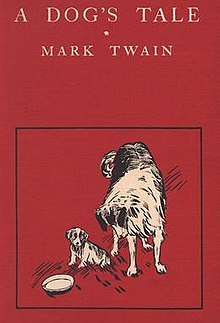Here is the complete list of books published by Mark Twain, one of the most beloved American writers in the 19th century, a lecturer, a publisher, entrepreneur, and humorist.
According to William Faulkner, “Mark Twain is the father of American literature.” Some of his most celebrated novels include the adventures of Tom Sawyer (1876) and The adventures of Huckleberry Finn (1884).
Who Is Mark Twain?
Born on November 30, 1835, in Florida, Missouri, Mark Twain’s birth name is Samuel Langhorne Clemens. When he was four years old, he and his family moved to a nearby bustling rivertown called Hannibal.
When he was eight years old, his father, John Clemens, died before his time. His mother, Jane Clemens, was forced to become the head of the household, leaving him and his siblings to live in destitution for a couple of years.
Twain was able to keep up his education until he was 12 years old. In order to help his mom feed their family, he found work as an apprentice printer at the Hannibal Courier.
After three years, he got a job as an occasional writer and editor at the Hannibal Western Union, a small newspaper office owned by his brother, Orion.
Twain got a small break in 1857, when he began learning how to pilot a steamboat on the Mississippi. By 1859, he was working regularly as a licensed steamboat pilot flying the channels and shoals of the great river.
Twain was content for a few years until his career was forcibly cut short in 1861 by the Civil War, which stopped most and all civilian traffic on the river.
Eager to pursue a bright future despite the war, Twain decided to move to Nevada and California in 1861, where he lived for the next five years.
He found work as a reporter for the Virginia City Territorial Enterprise in 1862, where he adopted the pen name Mark Twain- a steamboat slang for 12 feet of water.
After that, Twain slowly became one of the most popular storytellers in the West. His writing style— satirical, funny, and irreverent, was lauded among his peers. He then made a mark in 1865, when one of his stories, Jim Smiley and his Jumping Frog, was printed in magazines and newspapers around the country.
Not long after, Twain published two of his most applauded novels, The Adventures of Tom Sawyer and The Adventures of Huckleberry Finn. According to biographer Everett Emerson, writing these two novels freed Twain temporarily from the “inhibitions of the culture he had chosen to embrace.”
He then continued to produce best-selling works, novels, and essays, living his life as a celebrated and well-respected author donned with several awards and honors, including degrees from Oxford and Yale.
He became one of the most prominent celebrities around the world, and traveled widely overseas. However, Twain suffered from depression, angst, and paranoia in his last few years of life, due to his family struggles which included the deaths of some of his children and wife.
Twain died on April 21, 1910, at the age of 74. His remains were laid to rest in Elmira, New York.
Mark Twain Complete Booklist & Summary
Here is Mark Twain’s complete list of works along with a short summary:
1) The Celebrated Jumping Frog of Calaveras County – 1865
 Book Summary: “The Celebrated Jumping Frog of Calaveras County” is an 1865 short story by Mark Twain. It was his first great success as a writer and brought him national attention.[1] The story has also been published as “Jim Smiley and His Jumping Frog” (its original title) and “The Notorious Jumping Frog of Calaveras County”. In it, the narrator retells a story he heard from a bartender, Simon Wheeler, at the Angels Hotel in Angels Camp, California, about the gambler Jim Smiley. The narrator describes him: “If he even seen a straddle bug start to go anywheres, he would bet you how long it would take him to get to wherever he going to, and if you took him up, he would foller that straddle bug to Mexico but what he would find out where he was bound for and how long he was on the road.”
Book Summary: “The Celebrated Jumping Frog of Calaveras County” is an 1865 short story by Mark Twain. It was his first great success as a writer and brought him national attention.[1] The story has also been published as “Jim Smiley and His Jumping Frog” (its original title) and “The Notorious Jumping Frog of Calaveras County”. In it, the narrator retells a story he heard from a bartender, Simon Wheeler, at the Angels Hotel in Angels Camp, California, about the gambler Jim Smiley. The narrator describes him: “If he even seen a straddle bug start to go anywheres, he would bet you how long it would take him to get to wherever he going to, and if you took him up, he would foller that straddle bug to Mexico but what he would find out where he was bound for and how long he was on the road.”- Book Reviews:
2) Advice to Little Girls – 1867
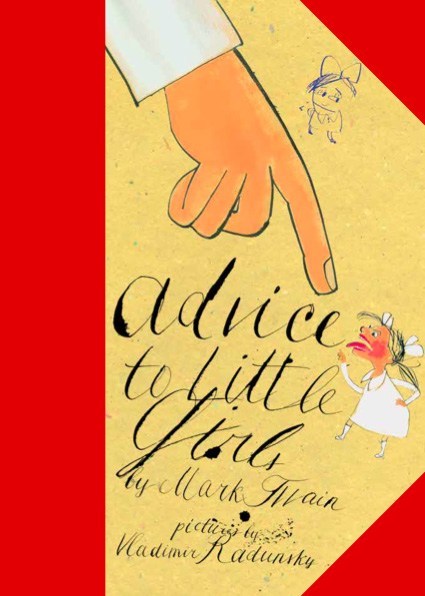 Book Summary: You should ever bear in mind that it is to your kind parents that you are indebted for your food, and for the privilege of staying home from school when you let on that you are sick. Therefore you ought to respect their little prejudices, and humor their little whims, and put up with their little foibles until they get to crowding you too much.When Mark Twain wrote the sparky short story “Advice to Little Girls” in 1865, he probably didn’t mean for it to be shown to them. Or maybe he did, since we all know Twain was a rascal. Now, author and illustrator Vladimir Radunsky has created a picture book based on Twain’s text that adds all the right outlandish touches.Born on November 30, 1835, in Florida, Missouri, Samuel L. Clemens wrote under the pen name Mark Twain. He wrote two major classics of American literature, The Adventures of Tom Sawyer and Adventures of Huckleberry Finn. He was also a riverboat pilot, journalist, lecturer, entrepreneur, and inventor. Whether or not it was Mark Twain’s actual intention for little girls to read this humorous short story, it’s clear that he did not talk down to children, but rather expected them to stretch themselves in order to grasp sophisticated, adult meaning.Vladimir Radunsky has illustrated many books to great acclaim. Recently, Radunsky has been moving farther and farther away from the traditional picture book and into other more innovative forms. The most recent example is a work published by HarperCollins of hip-hop poetry for children, where the graffiti art has migrated from the walls into a printed book. Radunsky has published more than thirty books for children, mostly in the United States. Many of them were translated and published in France, the United Kingdom, Italy, Spain, the Netherlands, Germany, and Japan.
Book Summary: You should ever bear in mind that it is to your kind parents that you are indebted for your food, and for the privilege of staying home from school when you let on that you are sick. Therefore you ought to respect their little prejudices, and humor their little whims, and put up with their little foibles until they get to crowding you too much.When Mark Twain wrote the sparky short story “Advice to Little Girls” in 1865, he probably didn’t mean for it to be shown to them. Or maybe he did, since we all know Twain was a rascal. Now, author and illustrator Vladimir Radunsky has created a picture book based on Twain’s text that adds all the right outlandish touches.Born on November 30, 1835, in Florida, Missouri, Samuel L. Clemens wrote under the pen name Mark Twain. He wrote two major classics of American literature, The Adventures of Tom Sawyer and Adventures of Huckleberry Finn. He was also a riverboat pilot, journalist, lecturer, entrepreneur, and inventor. Whether or not it was Mark Twain’s actual intention for little girls to read this humorous short story, it’s clear that he did not talk down to children, but rather expected them to stretch themselves in order to grasp sophisticated, adult meaning.Vladimir Radunsky has illustrated many books to great acclaim. Recently, Radunsky has been moving farther and farther away from the traditional picture book and into other more innovative forms. The most recent example is a work published by HarperCollins of hip-hop poetry for children, where the graffiti art has migrated from the walls into a printed book. Radunsky has published more than thirty books for children, mostly in the United States. Many of them were translated and published in France, the United Kingdom, Italy, Spain, the Netherlands, Germany, and Japan.
- Book Reviews:
3) General Washington’s Negro Body-servant – 1868
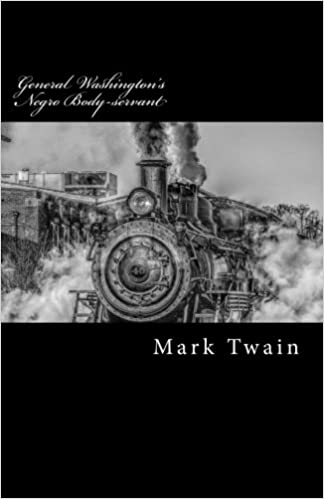 Book Summary: Samuel Langhorne Clemens (November 30, 1835 – April 21, 1910), better known by his pen name Mark Twain, was an American author and humorist. He wrote The Adventures of Tom Sawyer (1876) and its sequel, Adventures of Huckleberry Finn (1885), the latter often called “The Great American Novel”. Twain grew up in Hannibal, Missouri, which provided the setting for Huckleberry Finn and Tom Sawyer. After an apprenticeship with a printer, he worked as a typesetter and contributed articles to the newspaper of his older brother, Orion Clemens. He later became a riverboat pilot on the Mississippi River before heading west to join Orion in Nevada. He referred humorously to his singular lack of success at mining, turning to journalism for the Virginia City Territorial Enterprise. In 1865, his humorous story, “The Celebrated Jumping Frog of Calaveras County”, was published, based on a story he heard at Angels Hotel in Angels Camp, California, where he had spent some time as a miner. The short story brought international attention, and was even translated into classic Greek. His wit and satire, in prose and in speech, earned praise from critics and peers, and he was a friend to presidents, artists, industrialists, and European royalty. Though Twain earned a great deal of money from his writings and lectures, he invested in ventures that lost a great deal of money, notably the Paige Compositor, a mechanical typesetter, which failed because of its complexity and imprecision. In the wake of these financial setbacks, he filed for protection from his creditors via bankruptcy, and with the help of Henry Huttleston Rogers eventually overcame his financial troubles. Twain chose to pay all his pre-bankruptcy creditors in full, though he had no legal responsibility to do so. Twain was born shortly after a visit by Halley’s Comet, and he predicted that he would “go out with it”, too. He died the day after the comet returned. He was lauded as the “greatest American humorist of his age”, and William Faulkner called Twain “the father of American literature”. Twain began his career writing light, humorous verse, but evolved into a chronicler of the vanities, hypocrisies and murderous acts of mankind. At mid-career, with Huckleberry Finn, he combined rich humor, sturdy narrative and social criticism. Twain was a master at rendering colloquial speech and helped to create and popularize a distinctive American literature built on American themes and language. Many of Twain’s works have been suppressed at times for various reasons. Adventures of Huckleberry Finn has been repeatedly restricted in American high schools, not least for its frequent use of the word “nigger”, which was in common usage in the pre-Civil War period in which the novel was set.
Book Summary: Samuel Langhorne Clemens (November 30, 1835 – April 21, 1910), better known by his pen name Mark Twain, was an American author and humorist. He wrote The Adventures of Tom Sawyer (1876) and its sequel, Adventures of Huckleberry Finn (1885), the latter often called “The Great American Novel”. Twain grew up in Hannibal, Missouri, which provided the setting for Huckleberry Finn and Tom Sawyer. After an apprenticeship with a printer, he worked as a typesetter and contributed articles to the newspaper of his older brother, Orion Clemens. He later became a riverboat pilot on the Mississippi River before heading west to join Orion in Nevada. He referred humorously to his singular lack of success at mining, turning to journalism for the Virginia City Territorial Enterprise. In 1865, his humorous story, “The Celebrated Jumping Frog of Calaveras County”, was published, based on a story he heard at Angels Hotel in Angels Camp, California, where he had spent some time as a miner. The short story brought international attention, and was even translated into classic Greek. His wit and satire, in prose and in speech, earned praise from critics and peers, and he was a friend to presidents, artists, industrialists, and European royalty. Though Twain earned a great deal of money from his writings and lectures, he invested in ventures that lost a great deal of money, notably the Paige Compositor, a mechanical typesetter, which failed because of its complexity and imprecision. In the wake of these financial setbacks, he filed for protection from his creditors via bankruptcy, and with the help of Henry Huttleston Rogers eventually overcame his financial troubles. Twain chose to pay all his pre-bankruptcy creditors in full, though he had no legal responsibility to do so. Twain was born shortly after a visit by Halley’s Comet, and he predicted that he would “go out with it”, too. He died the day after the comet returned. He was lauded as the “greatest American humorist of his age”, and William Faulkner called Twain “the father of American literature”. Twain began his career writing light, humorous verse, but evolved into a chronicler of the vanities, hypocrisies and murderous acts of mankind. At mid-career, with Huckleberry Finn, he combined rich humor, sturdy narrative and social criticism. Twain was a master at rendering colloquial speech and helped to create and popularize a distinctive American literature built on American themes and language. Many of Twain’s works have been suppressed at times for various reasons. Adventures of Huckleberry Finn has been repeatedly restricted in American high schools, not least for its frequent use of the word “nigger”, which was in common usage in the pre-Civil War period in which the novel was set.- Book Reviews:
4) The Innocents Abroad – 1869
 Book Summary: A beautiful edition with the formatting and all 234 images from the original first edition published in 1869. The cover is from an Antonio Joli painting of Rome. Use Amazon’s Lookinside feature to compare this edition with others. You’ll be impressed by the differences. Don’t be fooled by other versions that have no illustrations or contain very small print. Reading our edition will make you feel that you are back traveling the Mediterranean with Mark. If you like our book, be sure to leave a review!Published under the full name The Innocents Abroad, or The New Pilgrims’ Progress, this became Mark Twain’s best selling book during his life and one of the best-selling travel books of all time. It is a detailed narrative of a long excursion with a group of fellow travelers to the Holy Land shortly after the Civil War aboard the vessel Quaker City. The humorous account covers his visits to Paris, Italy, Greece, Egypt and the Holy Land. At times irreverent, it is always entertaining.
Book Summary: A beautiful edition with the formatting and all 234 images from the original first edition published in 1869. The cover is from an Antonio Joli painting of Rome. Use Amazon’s Lookinside feature to compare this edition with others. You’ll be impressed by the differences. Don’t be fooled by other versions that have no illustrations or contain very small print. Reading our edition will make you feel that you are back traveling the Mediterranean with Mark. If you like our book, be sure to leave a review!Published under the full name The Innocents Abroad, or The New Pilgrims’ Progress, this became Mark Twain’s best selling book during his life and one of the best-selling travel books of all time. It is a detailed narrative of a long excursion with a group of fellow travelers to the Holy Land shortly after the Civil War aboard the vessel Quaker City. The humorous account covers his visits to Paris, Italy, Greece, Egypt and the Holy Land. At times irreverent, it is always entertaining.
- Book Reviews:
5) Journalism in Tennessee – 1869
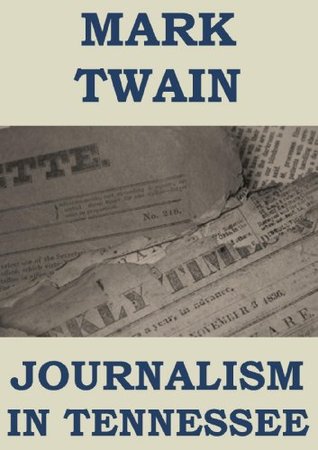 Book Summary: “Journalism in Tennessee” is one of the best-known short stories by Mark Twain (pen-name of Samuel Clemens, 1835-1910). First published in 1869, the tale is a satire of nineteenth century American newspapers.The ebook also contains a selection of Twain’s best aphorisms and a biographical note on the author.
Book Summary: “Journalism in Tennessee” is one of the best-known short stories by Mark Twain (pen-name of Samuel Clemens, 1835-1910). First published in 1869, the tale is a satire of nineteenth century American newspapers.The ebook also contains a selection of Twain’s best aphorisms and a biographical note on the author.
- Book Reviews:
6) About Barbers – 1871
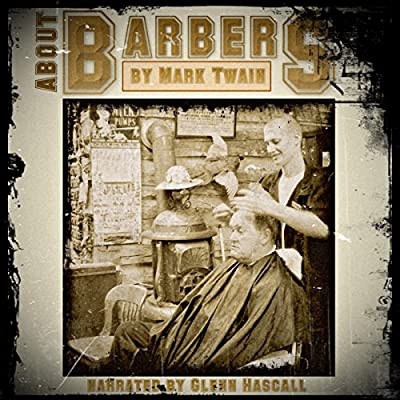 Book Summary: This is a story for any man that has ever visited a barber. For all the good they do, there has likely been at least one misguided barber who resembles the man who gives Mark Twain’s head a workout. From the descriptions of the shop to the tactics of those who use a barber, this story will be something you can relate to, smile at, and reintroduces memories of a barber shop that never changes. Narrated by Glenn Hascall.
Book Summary: This is a story for any man that has ever visited a barber. For all the good they do, there has likely been at least one misguided barber who resembles the man who gives Mark Twain’s head a workout. From the descriptions of the shop to the tactics of those who use a barber, this story will be something you can relate to, smile at, and reintroduces memories of a barber shop that never changes. Narrated by Glenn Hascall.
- Book Reviews:
7) Mark Twain’s (Burlesque) Autobiography and First Romance – 1871
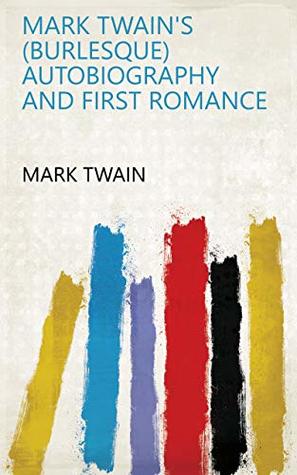 Book Summary: This is a reproduction of a classic text optimised for kindle devices. We have endeavoured to create this version as close to the original artefact as possible. Although occasionally there may be certain imperfections with these old texts, we believe they deserve to be made available for future generations to enjoy.
Book Summary: This is a reproduction of a classic text optimised for kindle devices. We have endeavoured to create this version as close to the original artefact as possible. Although occasionally there may be certain imperfections with these old texts, we believe they deserve to be made available for future generations to enjoy.
- Book Reviews:
8) Roughing It – 1872
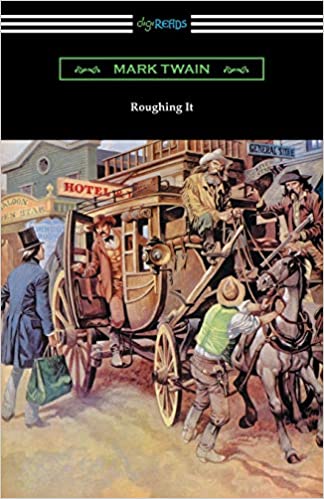 Book Summary: Mark Twain’s semi-autobiographical travel memoir, “Roughing It” was written between 1870-1871 and subsequently published in 1872. Billed as a prequel to “Innocents Abroad”, in which Twain details his travels aboard a pleasure cruise through Europe and the Holy Land in 1867, “Roughing It” conversely documents Twain’s early days in the old wild west between the years 1861-1867. Employing his characteristically humoristic wit and flare for regional dialect, Twain crafts a story which at once explores the magnificence of the wild west and dispels its romanticized mythology. Called out west to help his brother, Orion, who has been appointed secretary of Nevada, the two travel from their homes in Missouri aboard the Overland Stage. In relating the trip, the rugged brilliance of the open frontier of the American West is beautifully depicted. Parting ways with his brother, Twain continues on from Salt Lake City to San Francisco and ultimately the kingdom of Hawaii. Along the way numerous anecdotes of humorous adventures and mishaps of Twain’s experiences with Mormons, Native Americans, mining, and real estate speculation are satirically told. A classic travelogue, “Roughing It” is one of Twain’s greatest non-fictional works. This edition is printed on premium acid-free paper.
Book Summary: Mark Twain’s semi-autobiographical travel memoir, “Roughing It” was written between 1870-1871 and subsequently published in 1872. Billed as a prequel to “Innocents Abroad”, in which Twain details his travels aboard a pleasure cruise through Europe and the Holy Land in 1867, “Roughing It” conversely documents Twain’s early days in the old wild west between the years 1861-1867. Employing his characteristically humoristic wit and flare for regional dialect, Twain crafts a story which at once explores the magnificence of the wild west and dispels its romanticized mythology. Called out west to help his brother, Orion, who has been appointed secretary of Nevada, the two travel from their homes in Missouri aboard the Overland Stage. In relating the trip, the rugged brilliance of the open frontier of the American West is beautifully depicted. Parting ways with his brother, Twain continues on from Salt Lake City to San Francisco and ultimately the kingdom of Hawaii. Along the way numerous anecdotes of humorous adventures and mishaps of Twain’s experiences with Mormons, Native Americans, mining, and real estate speculation are satirically told. A classic travelogue, “Roughing It” is one of Twain’s greatest non-fictional works. This edition is printed on premium acid-free paper.
- Book Reviews:
9) The Gilded Age: A Tale of Today – 1873
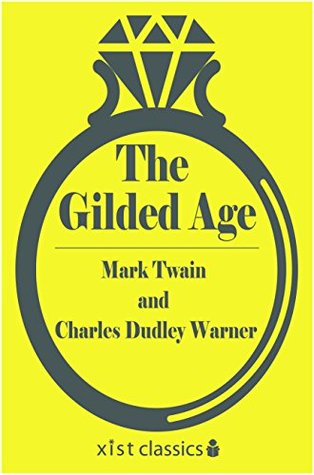 Book Summary: A Novel of Today
Book Summary: A Novel of Today
“It is a time when one’s spirit is subdued and sad, one knows not why; when the past seems a storm-swept desolation, life a vanity and a burden, and the future but a way to death. It is a time when one is filled with vague longings; when one dreams of flight to peaceful islands in the remote solitudes of the sea, or folds his hands and says, What is the use of struggling, and toiling and worrying any more? let us give it all up.” – Mark Twain, Charles Dudley Warner, The Gilded AgeIn post-Civil War America, everyone wants to get rich. Si Hawkins, a member of a poor Tennessee family wants to sell some land at the right price. However, the price is never right so Si Hawkins dies. His daughter, Laura leaves her home for Washington D.C. where she tries to learn the politician’s wicked schemes. In a parallel story, two upper class young men dream of speculating land prices and being filthy rich. Who will succeed and who will fail?This Xist Classics edition has been professionally formatted for e-readers with a linked table of contents. This ebook also contains a bonus book club leadership guide and discussion questions. We hope you’ll share this book with your friends, neighbors and colleagues and can’t wait to hear what you have to say about it.Xist Publishing is a digital-first publisher. Xist Publishing creates books for the touchscreen generation and is dedicated to helping everyone develop a lifetime love of reading, no matter what form it takes
- Book Reviews:
10) Sketches New and Old – 1875
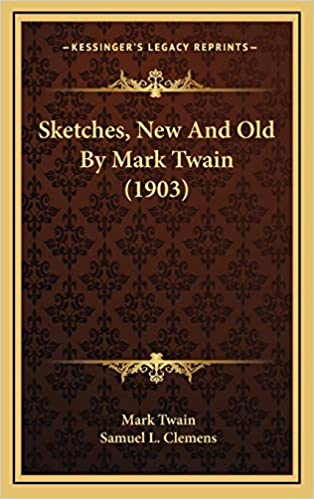 Book Summary: This scarce antiquarian book is a facsimile reprint of the original. Due to its age, it may contain imperfections such as marks, notations, marginalia and flawed pages. Because we believe this work is culturally important, we have made it available as part of our commitment for protecting, preserving, and promoting the world’s literature in affordable, high quality, modern editions that are true to the original work.
Book Summary: This scarce antiquarian book is a facsimile reprint of the original. Due to its age, it may contain imperfections such as marks, notations, marginalia and flawed pages. Because we believe this work is culturally important, we have made it available as part of our commitment for protecting, preserving, and promoting the world’s literature in affordable, high quality, modern editions that are true to the original work.
- Book Reviews:
11) Old Times on the Mississippi – 1875
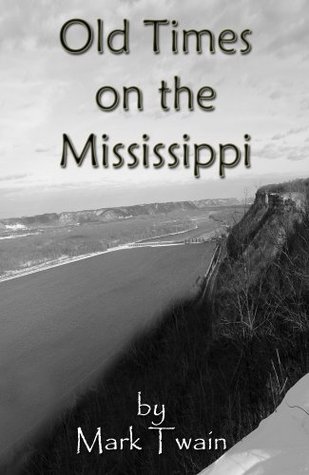 Book Summary: This is a rare non-fiction autobiographical story by Mark Twain in which he talks about his early days of riding on a steamboat throughout the Mississippi River. His experiences on this river would later help him write his famous fictional stories involving Tom Sawyer and Huckleberry Finn. This version of the book features old pictures of the river and the steamboats of the 1800s.
Book Summary: This is a rare non-fiction autobiographical story by Mark Twain in which he talks about his early days of riding on a steamboat throughout the Mississippi River. His experiences on this river would later help him write his famous fictional stories involving Tom Sawyer and Huckleberry Finn. This version of the book features old pictures of the river and the steamboats of the 1800s.
- Book Reviews:
12) The Curious Republic of Gondour – 1875
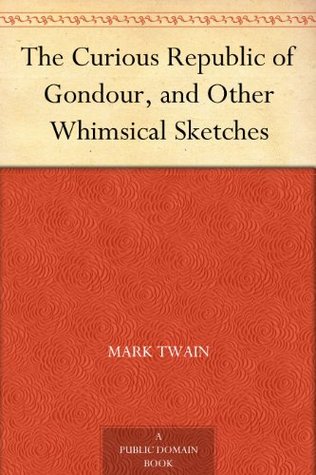 Book Summary: This book was converted from its physical edition to the digital format by a community of volunteers. You may find it for free on the web. Purchase of the Kindle edition includes wireless delivery.
Book Summary: This book was converted from its physical edition to the digital format by a community of volunteers. You may find it for free on the web. Purchase of the Kindle edition includes wireless delivery.
- Book Reviews:
13) The Facts Concerning the Recent Carnival of Crime in Connecticut – 1876
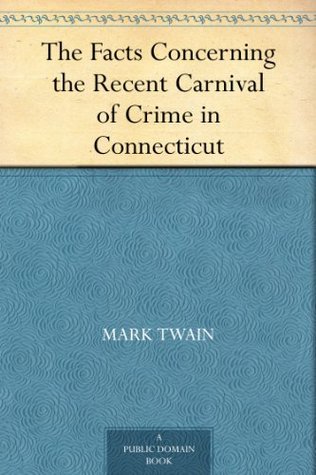 Book Summary: This book was converted from its physical edition to the digital format by a community of volunteers. You may find it for free on the web. Purchase of the Kindle edition includes wireless delivery.
Book Summary: This book was converted from its physical edition to the digital format by a community of volunteers. You may find it for free on the web. Purchase of the Kindle edition includes wireless delivery.
- Book Reviews:
14) The Adventures of Tom Sawyer – 1876
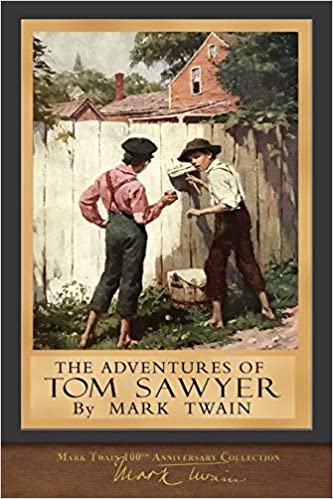 Book Summary: Unabridged and Uncensored. NOTE: Please ignore any negative reviews about small print, bad format, skinny book,etc. since they are about other versions of this title. Our edition has none of those problems – text is normal size, it is fully illustrated with original drawings, pages are numbered–it is a very nice edition.
Book Summary: Unabridged and Uncensored. NOTE: Please ignore any negative reviews about small print, bad format, skinny book,etc. since they are about other versions of this title. Our edition has none of those problems – text is normal size, it is fully illustrated with original drawings, pages are numbered–it is a very nice edition.
A beautiful edition with the formatting and all 162 images from the original first edition published in 1876. The cover is a Worth Brehm painting taken from a later publication. Use Amazon’s Lookinside feature to compare this edition with others. You’ll be impressed by the differences. Don’t be fooled by other versions that have no illustrations or contain very small print. Reading our edition will make you feel that you are back on the Mississippi River with Tom and Huck. If you like our book, be sure to leave a review!Mark Twain created the memorable characters Tom Sawyer and Huckleberry Finn drawing from the experiences of boys he grew up with in Missouri. Set by the Mississippi River in the 1840’s, it follows these boys as they get into predicament after predicament. Tom’s classic whitewashing of the fence has become part of American legend, and the book paints a nostalgic picture of life in the middle of the nineteenth century. Tom runs away from home to an island in the river, chases Injun Joe and his treasure, and even gets trapped in a cave for days with Becky Thatcher. The book is one of Twain’s most beloved stories.
- Book Reviews:
15) A Literary Nightmare – 1876
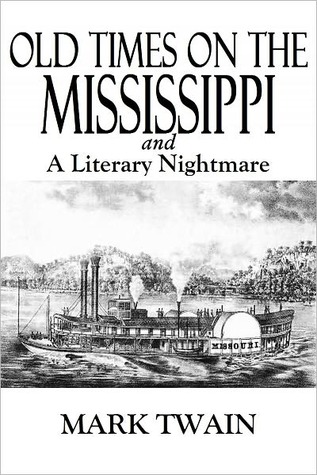 Book Summary: Scanned, proofed and corrected from the original edition for your reading pleasure. (Worth every penny!)***Below are are few excerpts from the book and as Shakespeare said: “What’s in a name?”***”Jim, how did you run Plum Point, coming up?””It was in the night, there, and I ran it the way one of the boys on the Diana told me; started out about fifty yards above the wood pile on the false point, and held on the cabin under Plum Point till I raised the reef quarter less twain— then straightened up for the middle bar till I got well abreast the old one-limbed cotton-wood in the bend, then got my stern on the cotton-wood and head on the low place above the point, and came through a-booming — nine and a half.””Pretty square crossing, an’t it?””Yes, but the upper bar’s working down fast.”Another pilot spoke up and said:—”I had better water than that, and ran it lower down; started out from the false point— mark twain— raised the second reef abreast the big snag in the bend, and had quarter less twain.”**********”Labboard lead, there! Stabboard lead!”
Book Summary: Scanned, proofed and corrected from the original edition for your reading pleasure. (Worth every penny!)***Below are are few excerpts from the book and as Shakespeare said: “What’s in a name?”***”Jim, how did you run Plum Point, coming up?””It was in the night, there, and I ran it the way one of the boys on the Diana told me; started out about fifty yards above the wood pile on the false point, and held on the cabin under Plum Point till I raised the reef quarter less twain— then straightened up for the middle bar till I got well abreast the old one-limbed cotton-wood in the bend, then got my stern on the cotton-wood and head on the low place above the point, and came through a-booming — nine and a half.””Pretty square crossing, an’t it?””Yes, but the upper bar’s working down fast.”Another pilot spoke up and said:—”I had better water than that, and ran it lower down; started out from the false point— mark twain— raised the second reef abreast the big snag in the bend, and had quarter less twain.”**********”Labboard lead, there! Stabboard lead!”
The cries of the leadsmen began to rise out of the distance, and were gruffly repeated by the word-passers on the hurricane deck.”M-a-r-k three! M-a-r-k three! Quarter-less-three! Half twain! Quarter twain! M-a-r-k twain! Quarter-less”—**********That night we had the watch until twelve. Now it was an ancient river custom for the two pilots to chat a bit when the watch changed. While the relieving pilot put on his gloves and lit his cigar, his partner, the retiring pilot, would say something like this:—”I judge the upper bar is making down a little at Hale’s Point; had quarter twain with the lower lead and mark twain with the other.”**********This was another shock. I began to climb the wheel like a squirrel; but I would hardly get the boat started to port before I would see new dangers on that side, and away I would spin to the other; only to find perils accumulating to starboard, and be crazy to get to port again. Then came the leadsman’s sepulchral cry:—”D-e-e-p four!”Deep four in a bottomless crossing! The terror of it took my breath away.”M-a-r-k three! M-a-r-k three! Quarter less three! Half twain!”This was frightful! I seized the bell-ropes and stopped the engines.
“Quarter twain! Quarter twain! Mark twain!”
- Book Reviews:
16) A Tramp Abroad – 1880
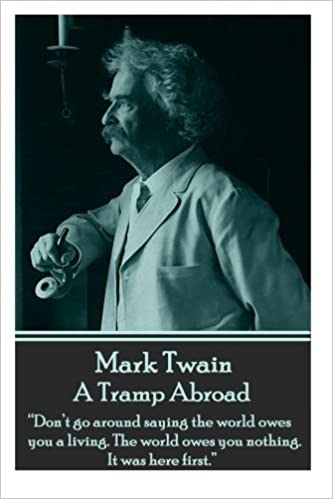 Book Summary: Samuel Langhorne Clemens was born in 1835 and is far better known by his pen name; Mark Twain. An American author and humorist of the first order he is perhaps most famous for his novels, The Adventures Of Tom Sawyer, written in 1876, and its sequel, The Adventures Of Huckleberry Finn, written in 1885 and often described with that mythic line – “the Great American Novel.” Twain grew up in Hannibal, Missouri, which would later provide the backdrop for these great novels. Apprenticed to a printer he also worked as a typesetter but eventually became a master riverboat pilot on the Mississippi River. Later, heading west with his brother, Orion to make his fortune he failed at gold mining and instead turned to journalism and found his true calling as a writer of humorous stories. His wit and humour sparkle from every page, his craft evident with every phase and punctured target. Of course as a master of his craft his observations on people, situations and locations create a fabric of great texture and detail and this reflects across short stories, novels and his travel writings. Twain was born during a visit by Halley’s Comet, and predicted that he would “go out with it” as well. He died the day following the comet’s subsequent return in 1910. Here we present A Tramp Abroad.
Book Summary: Samuel Langhorne Clemens was born in 1835 and is far better known by his pen name; Mark Twain. An American author and humorist of the first order he is perhaps most famous for his novels, The Adventures Of Tom Sawyer, written in 1876, and its sequel, The Adventures Of Huckleberry Finn, written in 1885 and often described with that mythic line – “the Great American Novel.” Twain grew up in Hannibal, Missouri, which would later provide the backdrop for these great novels. Apprenticed to a printer he also worked as a typesetter but eventually became a master riverboat pilot on the Mississippi River. Later, heading west with his brother, Orion to make his fortune he failed at gold mining and instead turned to journalism and found his true calling as a writer of humorous stories. His wit and humour sparkle from every page, his craft evident with every phase and punctured target. Of course as a master of his craft his observations on people, situations and locations create a fabric of great texture and detail and this reflects across short stories, novels and his travel writings. Twain was born during a visit by Halley’s Comet, and predicted that he would “go out with it” as well. He died the day following the comet’s subsequent return in 1910. Here we present A Tramp Abroad.
- Book Reviews:
17) Edward Mills and George Benton: A Tale – 1880
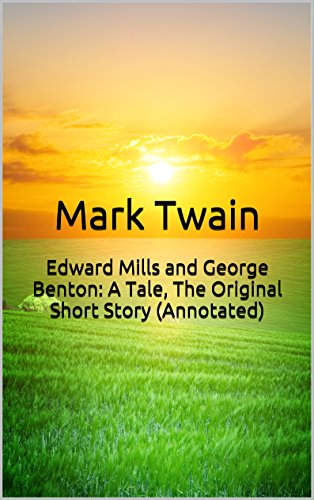 Book Summary: (Edward Mills and George Benton: A Tale, Mark Twain)Includes:
Book Summary: (Edward Mills and George Benton: A Tale, Mark Twain)Includes:
100 famous quotes of Mark Twain,
Complete bibliography of Mark Twain,
Biography of Mark Twain,These two were distantly related to each other—seventh cousins, or something of that sort. While still babies they became orphans, and were adopted by the Brants, a childless couple, who quickly grew very fond of them. The Brants were always saying: “Be pure, honest, sober, industrious, and considerate of others, and success in life is assured.” The children heard this repeated some thousands of times before they understood it; they could repeat it themselves long before they could say the Lord’s Prayer; it was painted over the nursery door, and was about the first thing they learned to read. It was destined to be the unswerving rule of Edward Mills’s life. Sometimes the Brants changed the wording a little, and said: “Be pure, honest, sober, industrious, considerate, and you will never lack friends.”
- Book Reviews:
18) The Awful German Language – 1880
 Book Summary: A wonderful book full of satire about the German language. Written by the genius Mark Twain. This is half German and half English, so it is a great way to pick up on key German words. This copy is still in its original wrapping, so it has never been opened. It is brand new, and ready to be read.
Book Summary: A wonderful book full of satire about the German language. Written by the genius Mark Twain. This is half German and half English, so it is a great way to pick up on key German words. This copy is still in its original wrapping, so it has never been opened. It is brand new, and ready to be read.
- Book Reviews:
19) Mrs. McWilliams and the Lightning – 1880
 Book Summary: Mrs. McWilliams and the Lightning is a piece of short fiction by Mark Twain. Samuel Langhorne Clemens (November 30, 1835 – April 21, 1910), better known by his pen name Mark Twain, was an American author and humorist. He wrote The Adventures of Tom Sawyer (1876) and its sequel, Adventures of Huckleberry Finn (1885), the latter often called “The Great American Novel”. Twain grew up in Hannibal, Missouri, which provided the setting for Huckleberry Finn and Tom Sawyer. After an apprenticeship with a printer, he worked as a typesetter and contributed articles to the newspaper of his older brother, Orion Clemens. He later became a riverboat pilot on the Mississippi River before heading west to join Orion in Nevada. He referred humorously to his singular lack of success at mining, turning to journalism for the Virginia City Territorial Enterprise. In 1865, his humorous story, “The Celebrated Jumping Frog of Calaveras County”, was published, based on a story he heard at Angels Hotel in Angels Camp, California, where he had spent some time as a miner. The short story brought international attention, and was even translated into classic Greek. His wit and satire, in prose and in speech, earned praise from critics and peers, and he was a friend to presidents, artists, industrialists, and European royalty. Though Twain earned a great deal of money from his writings and lectures, he invested in ventures that lost a great deal of money, notably the Paige Compositor, a mechanical typesetter, which failed because of its complexity and imprecision. In the wake of these financial setbacks, he filed for protection from his creditors via bankruptcy, and with the help of Henry Huttleston Rogers eventually overcame his financial troubles. Twain chose to pay all his pre-bankruptcy creditors in full, though he had no legal responsibility to do so. Twain was born shortly after a visit by Halley’s Comet, and he predicted that he would “go out with it”, too. He died the day after the comet returned. He was lauded as the “greatest American humorist of his age”, and William Faulkner called Twain “the father of American literature”.
Book Summary: Mrs. McWilliams and the Lightning is a piece of short fiction by Mark Twain. Samuel Langhorne Clemens (November 30, 1835 – April 21, 1910), better known by his pen name Mark Twain, was an American author and humorist. He wrote The Adventures of Tom Sawyer (1876) and its sequel, Adventures of Huckleberry Finn (1885), the latter often called “The Great American Novel”. Twain grew up in Hannibal, Missouri, which provided the setting for Huckleberry Finn and Tom Sawyer. After an apprenticeship with a printer, he worked as a typesetter and contributed articles to the newspaper of his older brother, Orion Clemens. He later became a riverboat pilot on the Mississippi River before heading west to join Orion in Nevada. He referred humorously to his singular lack of success at mining, turning to journalism for the Virginia City Territorial Enterprise. In 1865, his humorous story, “The Celebrated Jumping Frog of Calaveras County”, was published, based on a story he heard at Angels Hotel in Angels Camp, California, where he had spent some time as a miner. The short story brought international attention, and was even translated into classic Greek. His wit and satire, in prose and in speech, earned praise from critics and peers, and he was a friend to presidents, artists, industrialists, and European royalty. Though Twain earned a great deal of money from his writings and lectures, he invested in ventures that lost a great deal of money, notably the Paige Compositor, a mechanical typesetter, which failed because of its complexity and imprecision. In the wake of these financial setbacks, he filed for protection from his creditors via bankruptcy, and with the help of Henry Huttleston Rogers eventually overcame his financial troubles. Twain chose to pay all his pre-bankruptcy creditors in full, though he had no legal responsibility to do so. Twain was born shortly after a visit by Halley’s Comet, and he predicted that he would “go out with it”, too. He died the day after the comet returned. He was lauded as the “greatest American humorist of his age”, and William Faulkner called Twain “the father of American literature”.
- Book Reviews:
20) A Telephonic Conversation – 1880
 Book Summary: (A Telephonic Conversation, Mark Twain)Includes:
Book Summary: (A Telephonic Conversation, Mark Twain)Includes:
100 famous quotes of Mark Twain,
Complete bibliography of Mark Twain,
Biography of Mark Twain,Consider that a conversation by telephone—when you are simply siting by and not taking any part in that conversation—is one of the solemnest curiosities of modern life. Yesterday I was writing a deep article on a sublime philosophical subject while such a conversation was going on in the room. I notice that one can always write best when somebody is talking through a telephone close by. Well, the thing began in this way. A member of our household came in and asked me to have our house put into communication with Mr. Bagley’s downtown. I have observed, in many cities, that the sex always shrink from calling up the central office themselves. I don’t know why, but they do. So I touched the bell, and this talk ensued:
- Book Reviews:
21) The Prince and the Pauper – 1881
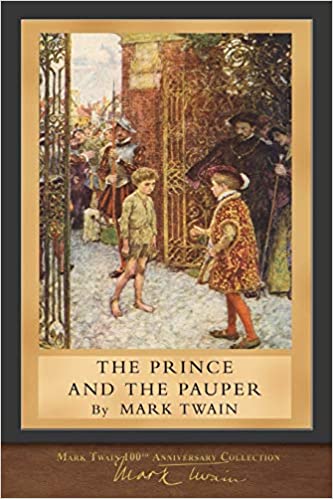 Book Summary: A beautiful edition with the formatting and all 190 images from the original first edition published in 1889. The cover is a painting taken from a later publication. Use Amazon’s Lookinside feature to compare this edition with others. You’ll be impressed by the differences. Don’t be fooled by other versions that have no illustrations or contain very small print. Reading our edition will make you feel that you are back in medieval England. If you like our book, be sure to leave a review!Published in 1882, The Prince and the Pauper is a delightful piece of historical fiction set in 1547. The young British Prince Edward, son of Henry VIII, switches place with a young pauper boy, Tom Canty, who happens to look exactly like the Prince. Tom takes over royal duties when King Henry dies and enjoys life in the palace. The real Prince is tossed out on the streets of London and learns about the life and misery of the common people of England at the time. He arrives back in the palace just in time to stop the coronation of the false Prince and take his rightful crown. He uses what he learned in his travels to rule as a benevolent King The real Prince Edward ruled until his early death at the age of 15.
Book Summary: A beautiful edition with the formatting and all 190 images from the original first edition published in 1889. The cover is a painting taken from a later publication. Use Amazon’s Lookinside feature to compare this edition with others. You’ll be impressed by the differences. Don’t be fooled by other versions that have no illustrations or contain very small print. Reading our edition will make you feel that you are back in medieval England. If you like our book, be sure to leave a review!Published in 1882, The Prince and the Pauper is a delightful piece of historical fiction set in 1547. The young British Prince Edward, son of Henry VIII, switches place with a young pauper boy, Tom Canty, who happens to look exactly like the Prince. Tom takes over royal duties when King Henry dies and enjoys life in the palace. The real Prince is tossed out on the streets of London and learns about the life and misery of the common people of England at the time. He arrives back in the palace just in time to stop the coronation of the false Prince and take his rightful crown. He uses what he learned in his travels to rule as a benevolent King The real Prince Edward ruled until his early death at the age of 15.
- Book Reviews:
22) The Stolen White Elephant – 1882
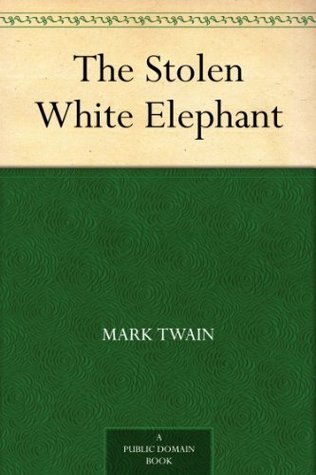 Book Summary: This book was converted from its physical edition to the digital format by a community of volunteers. You may find it for free on the web. Purchase of the Kindle edition includes wireless delivery.
Book Summary: This book was converted from its physical edition to the digital format by a community of volunteers. You may find it for free on the web. Purchase of the Kindle edition includes wireless delivery.
- Book Reviews:
23) On the Decay of the Art of Lying – 1882
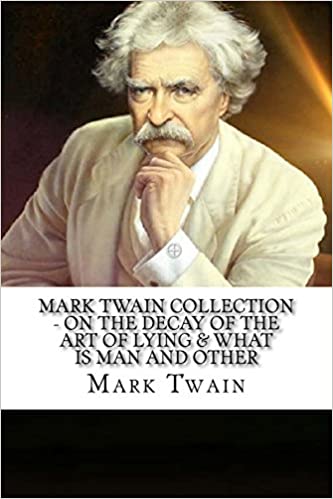 Book Summary: On the Decay of the Art of Lying is a short essay by Mark Twain from 1885. In it he deplores that way man’s “most faithful friend” is being used and indeed misused, declaring that “the wise thing is for us diligently to train ourselves to lie thoughtfully, judiciously; to lie with a good object, and not an evil one; to lie for others’ advantage, and not our own; to lie healingly, charitably, humanely, not cruelly, hurtfully, maliciously; to lie gracefully and graciously, not awkwardly and clumsily; to lie firmly, frankly, squarely, with head erect, not haltingly, tortuously, with pusillanimous mien, as being ashamed of our high calling.” Although Mark Twain is revered as a master of American fiction, he was also known in his time for possessing a remarkable facility with the essay form. This collection of surprisingly insightful non-fiction and fiction pieces showcases Twain’s astounding breadth as a writer. A must-read for fans of Twain’s no-nonsense prose.
Book Summary: On the Decay of the Art of Lying is a short essay by Mark Twain from 1885. In it he deplores that way man’s “most faithful friend” is being used and indeed misused, declaring that “the wise thing is for us diligently to train ourselves to lie thoughtfully, judiciously; to lie with a good object, and not an evil one; to lie for others’ advantage, and not our own; to lie healingly, charitably, humanely, not cruelly, hurtfully, maliciously; to lie gracefully and graciously, not awkwardly and clumsily; to lie firmly, frankly, squarely, with head erect, not haltingly, tortuously, with pusillanimous mien, as being ashamed of our high calling.” Although Mark Twain is revered as a master of American fiction, he was also known in his time for possessing a remarkable facility with the essay form. This collection of surprisingly insightful non-fiction and fiction pieces showcases Twain’s astounding breadth as a writer. A must-read for fans of Twain’s no-nonsense prose.
- Book Reviews:
24) Life on the Mississippi – 1883
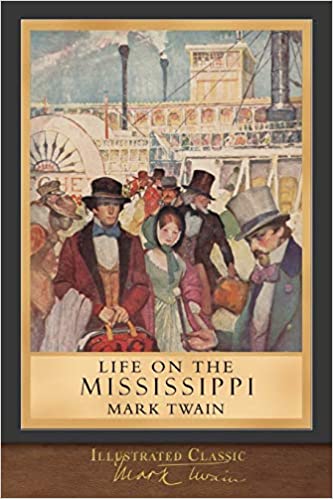 Book Summary: A beautiful edition with the formatting and more than 300 illustrations from the original first edition published in 1883.The cover is a Frank E. Schoonover painting taken from a later publication. Use Amazon’s Lookinside feature to compare this edition with others. You’ll be impressed by the differences. Don’t be fooled by other versions that have no illustrations or contain very small print. Reading our edition will make you feel that you are traveling down the Mississippi with Mark himself.Life on the Mississippi was released in 1883 as a memoir by Mark Twain of his days as a steamboat pilot on the Mississippi River before the American Civil War, as well as travels on the river after the war. The writing shows Twain’s love for the river and how it was uniquely American. The book was the first submitted for publishing as a typewritten manuscript.
Book Summary: A beautiful edition with the formatting and more than 300 illustrations from the original first edition published in 1883.The cover is a Frank E. Schoonover painting taken from a later publication. Use Amazon’s Lookinside feature to compare this edition with others. You’ll be impressed by the differences. Don’t be fooled by other versions that have no illustrations or contain very small print. Reading our edition will make you feel that you are traveling down the Mississippi with Mark himself.Life on the Mississippi was released in 1883 as a memoir by Mark Twain of his days as a steamboat pilot on the Mississippi River before the American Civil War, as well as travels on the river after the war. The writing shows Twain’s love for the river and how it was uniquely American. The book was the first submitted for publishing as a typewritten manuscript.
- Book Reviews:
25) Adventures of Huckleberry Finn – 1884
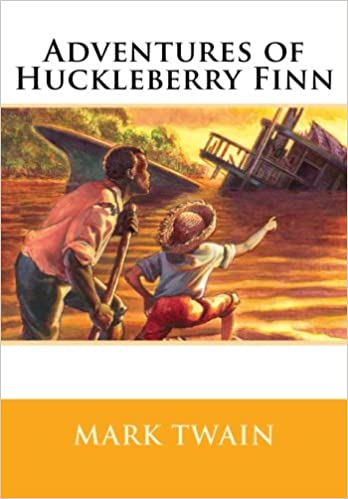 Book Summary: Adventures of Huckleberry Finn (or, in more recent editions, The Adventures of Huckleberry Finn) is a novel by Mark Twain, first published in the United Kingdom in December 1884 and in the United States in February 1885. Commonly named among the Great American Novels, the work is among the first in major American literature to be written throughout in vernacular English, characterized by local color regionalism. It is told in the first person by Huckleberry “Huck” Finn, a friend of Tom Sawyer and narrator of two other Twain novels (Tom Sawyer Abroad and Tom Sawyer, Detective). It is a direct sequel to The Adventures of Tom Sawyer.The book is noted for its colorful description of people and places along the Mississippi River. Set in a Southern antebellum society that had ceased to exist about twenty years before the work was published, Adventures of Huckleberry Finn is an often scathing satire on entrenched attitudes, particularly racism.Perennially popular with readers, Adventures of Huckleberry Finn has also been the continued object of study by literary critics since its publication. It was criticized upon release because of its coarse language and became even more controversial in the 20th century because of its perceived use of racial stereotypes and because of its frequent use of the racial slur “nigger”, despite strong arguments that the protagonist and the tenor of the book are anti-racist.
Book Summary: Adventures of Huckleberry Finn (or, in more recent editions, The Adventures of Huckleberry Finn) is a novel by Mark Twain, first published in the United Kingdom in December 1884 and in the United States in February 1885. Commonly named among the Great American Novels, the work is among the first in major American literature to be written throughout in vernacular English, characterized by local color regionalism. It is told in the first person by Huckleberry “Huck” Finn, a friend of Tom Sawyer and narrator of two other Twain novels (Tom Sawyer Abroad and Tom Sawyer, Detective). It is a direct sequel to The Adventures of Tom Sawyer.The book is noted for its colorful description of people and places along the Mississippi River. Set in a Southern antebellum society that had ceased to exist about twenty years before the work was published, Adventures of Huckleberry Finn is an often scathing satire on entrenched attitudes, particularly racism.Perennially popular with readers, Adventures of Huckleberry Finn has also been the continued object of study by literary critics since its publication. It was criticized upon release because of its coarse language and became even more controversial in the 20th century because of its perceived use of racial stereotypes and because of its frequent use of the racial slur “nigger”, despite strong arguments that the protagonist and the tenor of the book are anti-racist.
- Book Reviews:
26) The Private History of a Campaign That Failed – 1885
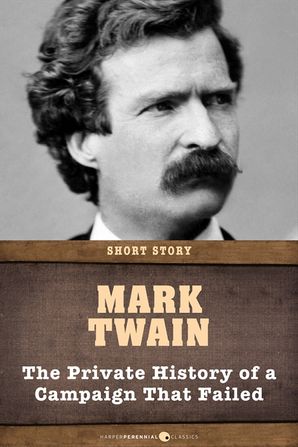 Book Summary: Written as a fictionalized account of Mark Twain’s own short-lived war experience, “The Private History of a Campaign That Failed” is a satiric sketch of the American South at the onset of the American Civil War. The narrative follows a small group of young men—dubbed “the Marion Rangers”—as they stumble around the backwoods of Marion County, Missouri, on patrol for Yankee troops. After avoiding improbable attacks, failing to tame unruly horses, and imposing on farmers for their food and supplies, the ensemble is finally met with the sobering reality of war when a man is shot and killed. In true Twain style, “The Private History of a Campaign That Failed” utilizes a comic and wryly humorous tone to strip the subject of war of heroism and romance.HarperPerennial Classics brings great works of literature to life in digital format, upholding the highest standards in ebook production and celebrating reading in all its forms. Look for more titles in the HarperPerennial Classics collection to build your digital library.
Book Summary: Written as a fictionalized account of Mark Twain’s own short-lived war experience, “The Private History of a Campaign That Failed” is a satiric sketch of the American South at the onset of the American Civil War. The narrative follows a small group of young men—dubbed “the Marion Rangers”—as they stumble around the backwoods of Marion County, Missouri, on patrol for Yankee troops. After avoiding improbable attacks, failing to tame unruly horses, and imposing on farmers for their food and supplies, the ensemble is finally met with the sobering reality of war when a man is shot and killed. In true Twain style, “The Private History of a Campaign That Failed” utilizes a comic and wryly humorous tone to strip the subject of war of heroism and romance.HarperPerennial Classics brings great works of literature to life in digital format, upholding the highest standards in ebook production and celebrating reading in all its forms. Look for more titles in the HarperPerennial Classics collection to build your digital library.
- Book Reviews:
27) A Connecticut Yankee in King Arthur’s Court – 1889
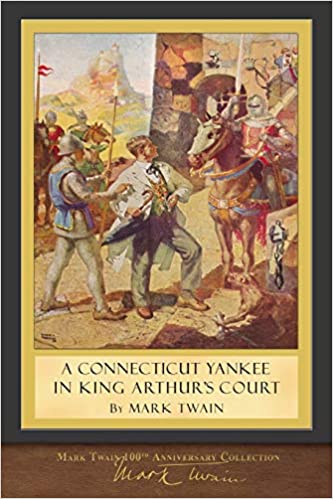 Book Summary: A Connecticut engineer named Hank Morgan gets knocked on the head and is transported back in time to medieval England during King Arthur’s reign. He is initially captured but uses his Yankee ingenuity to eventually become the boss of the realm. The book recounts his adventures and use of his ‘modern’ technology against the royalty, knights, and church of the day. He continually makes fun of the backwards nature of the citizens and rulers, and contrasts it to his democratic roots and ideals.
Book Summary: A Connecticut engineer named Hank Morgan gets knocked on the head and is transported back in time to medieval England during King Arthur’s reign. He is initially captured but uses his Yankee ingenuity to eventually become the boss of the realm. The book recounts his adventures and use of his ‘modern’ technology against the royalty, knights, and church of the day. He continually makes fun of the backwards nature of the citizens and rulers, and contrasts it to his democratic roots and ideals.
- Book Reviews:
28) Luck – 1891
 Book Summary: Luck is a classic humorous short story written by Mark Twain and first published in 1891. It’s about a hero who is really a fool, and why he owes it all to luck. Samuel Langhorne Clemens (November 30, 1835 – April 21, 1910), better known by his pen name Mark Twain, was an American author and humorist. He wrote The Adventures of Tom Sawyer (1876) and its sequel, Adventures of Huckleberry Finn (1885), the latter often called “The Great American Novel”. Twain grew up in Hannibal, Missouri, which provided the setting for Huckleberry Finn and Tom Sawyer. After an apprenticeship with a printer, he worked as a typesetter and contributed articles to the newspaper of his older brother, Orion Clemens. He later became a riverboat pilot on the Mississippi River before heading west to join Orion in Nevada. He referred humorously to his singular lack of success at mining, turning to journalism for the Virginia City Territorial Enterprise. In 1865, his humorous story, “The Celebrated Jumping Frog of Calaveras County”, was published, based on a story he heard at Angels Hotel in Angels Camp, California, where he had spent some time as a miner. The short story brought international attention, and was even translated into classic Greek. His wit and satire, in prose and in speech, earned praise from critics and peers, and he was a friend to presidents, artists, industrialists, and European royalty. Though Twain earned a great deal of money from his writings and lectures, he invested in ventures that lost a great deal of money, notably the Paige Compositor, a mechanical typesetter, which failed because of its complexity and imprecision. In the wake of these financial setbacks, he filed for protection from his creditors via bankruptcy, and with the help of Henry Huttleston Rogers eventually overcame his financial troubles. Twain chose to pay all his pre-bankruptcy creditors in full, though he had no legal responsibility to do so. Twain was born shortly after a visit by Halley’s Comet, and he predicted that he would “go out with it”, too. He died the day after the comet returned. He was lauded as the “greatest American humorist of his age”, and William Faulkner called Twain “the father of American literature”. Twain began his career writing light, humorous verse, but evolved into a chronicler of the vanities, hypocrisies and murderous acts of mankind. At mid-career, with Huckleberry Finn, he combined rich humor, sturdy narrative and social criticism. Twain was a master at rendering colloquial speech and helped to create and popularize a distinctive American literature built on American themes and language. Many of Twain’s works have been suppressed at times for various reasons. Adventures of Huckleberry Finn has been repeatedly restricted in American high schools, not least for its frequent use of the word “nigger”, which was in common usage in the pre-Civil War period in which the novel was set.
Book Summary: Luck is a classic humorous short story written by Mark Twain and first published in 1891. It’s about a hero who is really a fool, and why he owes it all to luck. Samuel Langhorne Clemens (November 30, 1835 – April 21, 1910), better known by his pen name Mark Twain, was an American author and humorist. He wrote The Adventures of Tom Sawyer (1876) and its sequel, Adventures of Huckleberry Finn (1885), the latter often called “The Great American Novel”. Twain grew up in Hannibal, Missouri, which provided the setting for Huckleberry Finn and Tom Sawyer. After an apprenticeship with a printer, he worked as a typesetter and contributed articles to the newspaper of his older brother, Orion Clemens. He later became a riverboat pilot on the Mississippi River before heading west to join Orion in Nevada. He referred humorously to his singular lack of success at mining, turning to journalism for the Virginia City Territorial Enterprise. In 1865, his humorous story, “The Celebrated Jumping Frog of Calaveras County”, was published, based on a story he heard at Angels Hotel in Angels Camp, California, where he had spent some time as a miner. The short story brought international attention, and was even translated into classic Greek. His wit and satire, in prose and in speech, earned praise from critics and peers, and he was a friend to presidents, artists, industrialists, and European royalty. Though Twain earned a great deal of money from his writings and lectures, he invested in ventures that lost a great deal of money, notably the Paige Compositor, a mechanical typesetter, which failed because of its complexity and imprecision. In the wake of these financial setbacks, he filed for protection from his creditors via bankruptcy, and with the help of Henry Huttleston Rogers eventually overcame his financial troubles. Twain chose to pay all his pre-bankruptcy creditors in full, though he had no legal responsibility to do so. Twain was born shortly after a visit by Halley’s Comet, and he predicted that he would “go out with it”, too. He died the day after the comet returned. He was lauded as the “greatest American humorist of his age”, and William Faulkner called Twain “the father of American literature”. Twain began his career writing light, humorous verse, but evolved into a chronicler of the vanities, hypocrisies and murderous acts of mankind. At mid-career, with Huckleberry Finn, he combined rich humor, sturdy narrative and social criticism. Twain was a master at rendering colloquial speech and helped to create and popularize a distinctive American literature built on American themes and language. Many of Twain’s works have been suppressed at times for various reasons. Adventures of Huckleberry Finn has been repeatedly restricted in American high schools, not least for its frequent use of the word “nigger”, which was in common usage in the pre-Civil War period in which the novel was set.
- Book Reviews:
29) The American Claimantt– 1892
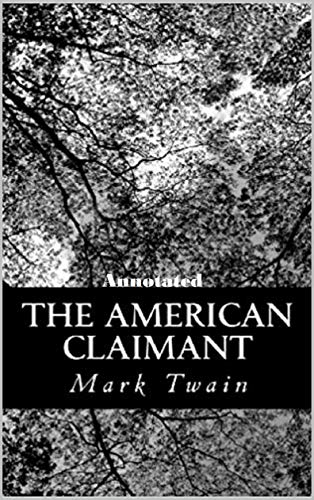 Book Summary: The American Claimant is an 1892 novel by American humorist and writer Mark Twain. Twain wrote the novel with the help of phonographic dictation, the first author according to Twain himself to do so.This was also according to Twain an attempt to write a book without mention of the weather, the first of its kind in fictitious literature although the first sentence of the second paragraph references weather fine, breezy morning. Indeed, all the weather is contained in an appendix, at the back of the book, which the reader is encouraged to turn to from time to time.
Book Summary: The American Claimant is an 1892 novel by American humorist and writer Mark Twain. Twain wrote the novel with the help of phonographic dictation, the first author according to Twain himself to do so.This was also according to Twain an attempt to write a book without mention of the weather, the first of its kind in fictitious literature although the first sentence of the second paragraph references weather fine, breezy morning. Indeed, all the weather is contained in an appendix, at the back of the book, which the reader is encouraged to turn to from time to time.
- Book Reviews:
30) Merry Tales – 1892
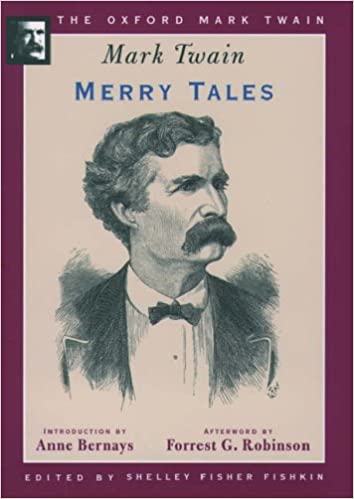 Book Summary: This collection of captivating tales displays Twain’s characteristic energy, imagination, and sense of fun, as well as the darkly satirical edge that marks so much of his work. His targets range from the difficulty of learning German (explored in a three-act play where two young lovers are obliged to conduct their courtship in beginning German), to the incompetence of military command (found in a sketch called “Luck” in which it is revealed that a celebrated general’s most lauded battle stratagem resulted from his confusing his right hand with his left). The best-known story in this collection is “The Private History of a Campaign That Failed,” one of the few pieces Twain ever wrote about his experiences in the Civil War. His friend William Dean Howells found it “immensely amusing, with such a bloody bit of heartache in it.” As Anne Bernays writes in her introduction, “unmatched in the care and handling of tone,” “The Private History of a Campaign That Failed” is “a merry tale about shattered innocence and slaughter, an antiwar manifesto that is also confession, dramatic monologue…and a romp that gradually turns into atrocity even as we watch.” It is a small masterpiece.
Book Summary: This collection of captivating tales displays Twain’s characteristic energy, imagination, and sense of fun, as well as the darkly satirical edge that marks so much of his work. His targets range from the difficulty of learning German (explored in a three-act play where two young lovers are obliged to conduct their courtship in beginning German), to the incompetence of military command (found in a sketch called “Luck” in which it is revealed that a celebrated general’s most lauded battle stratagem resulted from his confusing his right hand with his left). The best-known story in this collection is “The Private History of a Campaign That Failed,” one of the few pieces Twain ever wrote about his experiences in the Civil War. His friend William Dean Howells found it “immensely amusing, with such a bloody bit of heartache in it.” As Anne Bernays writes in her introduction, “unmatched in the care and handling of tone,” “The Private History of a Campaign That Failed” is “a merry tale about shattered innocence and slaughter, an antiwar manifesto that is also confession, dramatic monologue…and a romp that gradually turns into atrocity even as we watch.” It is a small masterpiece.
- Book Reviews:
31) The Million Pound Bank Note – 1893
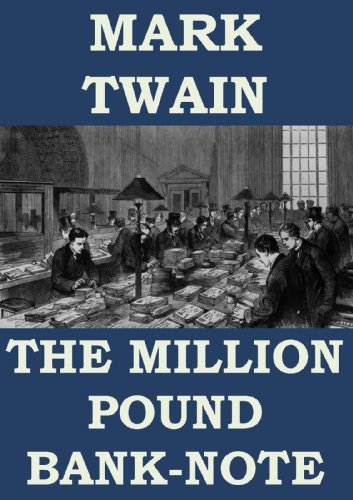 Book Summary: “The Million Pound Bank-Note” is one of the best-known short stories by Mark Twain (pen-name of Samuel Clemens, 1835-1910).First published in 1893, the story focuses on the adventure of a young broker in San Francisco, who loses everything and has to restart his life in London…The ebook also contains a selection of Twain’s best aphorisms and quotes, and a biographical note on the author.
Book Summary: “The Million Pound Bank-Note” is one of the best-known short stories by Mark Twain (pen-name of Samuel Clemens, 1835-1910).First published in 1893, the story focuses on the adventure of a young broker in San Francisco, who loses everything and has to restart his life in London…The ebook also contains a selection of Twain’s best aphorisms and quotes, and a biographical note on the author.
- Book Reviews:
32) The £1,000,000 Bank Note and Other New Stories – 1893
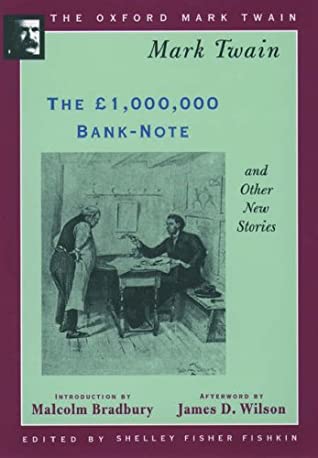 Book Summary: A delightful collection of diverse tales, ranging from short stories and personal essays to literary criticism and travel pieces, The £1,000,000 Bank-Note gathers together nine works, many of which are now unobtainable elsewhere, that testify to the range of Twain’s humor and the breadth of his interests. “The £1,000,000 Bank-Note,” one of Twain’s best-loved tales, is a wish-fulfillment fantasy in which a bet between two rich English eccentrics catapults a down-and-out clerk from San Francisco into wealth, status and fame in London society. The other pieces range from “Mental Telegraphy,” a serious essay reflecting Twain’s interest in extrasensory perception, to a tongue-in-cheek “Petition to the Queen of England” for relief from taxes. Readers will also find engaging travel essays, combining autobiographical reminiscence, tall tales, and ruminations on society and culture.
Book Summary: A delightful collection of diverse tales, ranging from short stories and personal essays to literary criticism and travel pieces, The £1,000,000 Bank-Note gathers together nine works, many of which are now unobtainable elsewhere, that testify to the range of Twain’s humor and the breadth of his interests. “The £1,000,000 Bank-Note,” one of Twain’s best-loved tales, is a wish-fulfillment fantasy in which a bet between two rich English eccentrics catapults a down-and-out clerk from San Francisco into wealth, status and fame in London society. The other pieces range from “Mental Telegraphy,” a serious essay reflecting Twain’s interest in extrasensory perception, to a tongue-in-cheek “Petition to the Queen of England” for relief from taxes. Readers will also find engaging travel essays, combining autobiographical reminiscence, tall tales, and ruminations on society and culture.
- Book Reviews:
33) Gold miners & guttersnipes – 1893
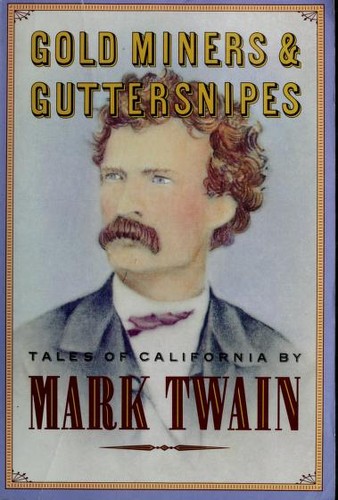 Book Summary: Mark Twain’s legendary insight and wit shine throughout this new selection of his writings, the first to focus on California. As a young man, the celebrated author of Huckleberry Finn, Tom Sawyer, and other classics spent the mid-1860s in California. In this collection of essays, newspaper articles, fiction, speeches, and letters, Twain presents his notoriously unconventional views on a state booming in the wake of the gold rush. His wry humor and irreverent social commentary illuminate everything from fashion, politics, and art to earthquakes, religion, and urban crime. Drawn from hard-to-find sources as well as his ever-popular books, Gold Miners and Guttersnipes: Tales of California by Mark Twain is a fresh and distinctive assortment by one of America’s favorite authors.
Book Summary: Mark Twain’s legendary insight and wit shine throughout this new selection of his writings, the first to focus on California. As a young man, the celebrated author of Huckleberry Finn, Tom Sawyer, and other classics spent the mid-1860s in California. In this collection of essays, newspaper articles, fiction, speeches, and letters, Twain presents his notoriously unconventional views on a state booming in the wake of the gold rush. His wry humor and irreverent social commentary illuminate everything from fashion, politics, and art to earthquakes, religion, and urban crime. Drawn from hard-to-find sources as well as his ever-popular books, Gold Miners and Guttersnipes: Tales of California by Mark Twain is a fresh and distinctive assortment by one of America’s favorite authors.
- Book Reviews:
34) Pudd’nhead Wilson – 1893
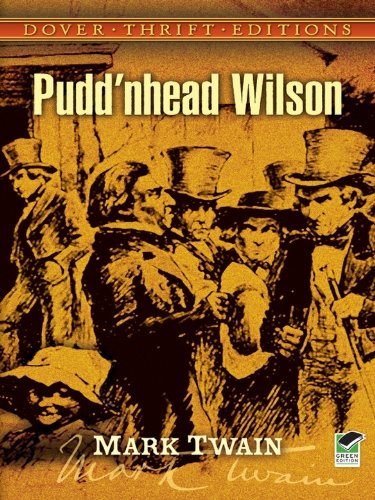 Book Summary: Switched at birth by a young slave woman attempting to protect her son from the horrors of slavery, a light-skinned infant changes places with the master’s white son. This simple premise is the basis of Pudd’nhead Wilson, a compelling drama that contains all the elements of a classic nineteenth-century mystery: reversed identities, a ghastly crime, an eccentric detective, and a tense courtroom scene.
Book Summary: Switched at birth by a young slave woman attempting to protect her son from the horrors of slavery, a light-skinned infant changes places with the master’s white son. This simple premise is the basis of Pudd’nhead Wilson, a compelling drama that contains all the elements of a classic nineteenth-century mystery: reversed identities, a ghastly crime, an eccentric detective, and a tense courtroom scene.
First published in 1894, Twain’s novel bristles with suspense. David “Pudd’nhead” Wilson, a wise but unorthodox lawyer who collects fingerprints as a hobby, wins back the respect of his townspeople when he solves a local murder in which two foreigners are falsely accused. Witty and absorbing, this novel features a literary first — the use of fingerprinting to solve a crime. This gem was Twain’s last novel about the antebellum South; and despite its frequent injections of humor, it offers a fierce condemnation of racial prejudice and a society that condoned slavery.
- Book Reviews:
35) Tom Sawyer Abroad – 1894
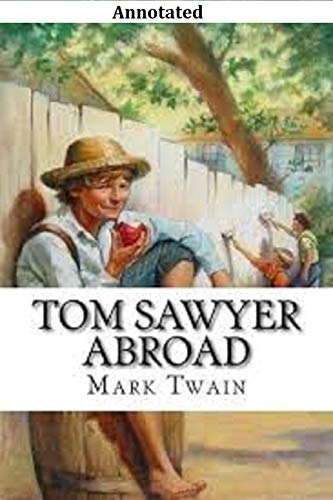 Book Summary: Tom Sawyer Abroad is a novel by Mark Twain published in 1894. It features Tom Sawyer and Huckleberry Finn in a parody of adventure stories like those of Jules Verne.In the story, Tom, Huck, and Jim travel to Africa in a futuristic hot air balloon, where they survive encounters with lions, robbers, and fleas to see some of the world’s greatest wonders, including the Pyramids and the Sphinx. Like Adventures of Huckleberry Finn and Tom Sawyer, Detective, the story is told using the first-person narrative voice of Huck Finn. It is a sequel, set in the time following the title story of the Tom Sawyer series.
Book Summary: Tom Sawyer Abroad is a novel by Mark Twain published in 1894. It features Tom Sawyer and Huckleberry Finn in a parody of adventure stories like those of Jules Verne.In the story, Tom, Huck, and Jim travel to Africa in a futuristic hot air balloon, where they survive encounters with lions, robbers, and fleas to see some of the world’s greatest wonders, including the Pyramids and the Sphinx. Like Adventures of Huckleberry Finn and Tom Sawyer, Detective, the story is told using the first-person narrative voice of Huck Finn. It is a sequel, set in the time following the title story of the Tom Sawyer series.
- Book Reviews:
36) Fenimore Cooper’s Literary Offenses – 1895
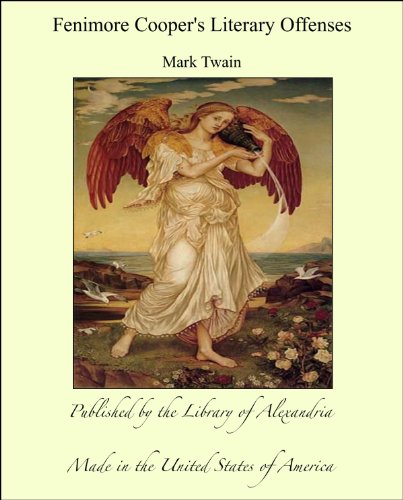 Book Summary: The Library of Alexandria is an independent small business publishing house. We specialize in bringing back to live rare, historical and ancient books. This includes manuscripts such as: classical fiction, philosophy, science, religion, folklore, mythology, history, literature, politics and sacred texts, in addition to secret and esoteric subjects, such as: occult, freemasonry, alchemy, hermetic, shamanism and ancient knowledge. Our books are available in digital format. We have approximately 50 thousand titles in 40 different languages and we work hard every single day in order to convert more titles to digital format and make them available for our readers. Currently, we have 2000 titles available for purchase in 35 Countries in addition to the United States, Canada, Australia and New Zealand. Our titles contain an interactive table of contents for ease of navigation of the book. We sincerely hope you enjoy these treasures in the form of digital books.
Book Summary: The Library of Alexandria is an independent small business publishing house. We specialize in bringing back to live rare, historical and ancient books. This includes manuscripts such as: classical fiction, philosophy, science, religion, folklore, mythology, history, literature, politics and sacred texts, in addition to secret and esoteric subjects, such as: occult, freemasonry, alchemy, hermetic, shamanism and ancient knowledge. Our books are available in digital format. We have approximately 50 thousand titles in 40 different languages and we work hard every single day in order to convert more titles to digital format and make them available for our readers. Currently, we have 2000 titles available for purchase in 35 Countries in addition to the United States, Canada, Australia and New Zealand. Our titles contain an interactive table of contents for ease of navigation of the book. We sincerely hope you enjoy these treasures in the form of digital books.
- Book Reviews:
37) Tom Sawyer, Detective – 1896
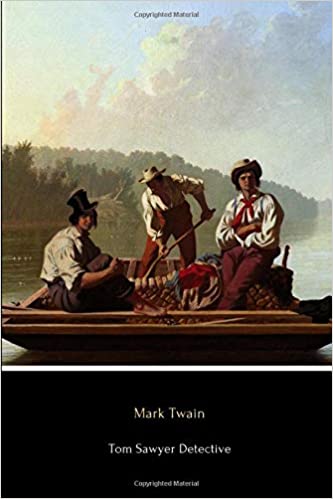 Book Summary: “It is better to remain silent and be thought a fool than to open one’s mouth and remove all doubt.”Everyone has heard of ‘The Adventures of Tom Sawyer’ (1876) and ‘The Adventures of Huckleberry Finn’. But did you know that there are two more Tom Sawyer books also written by Mark Twain?The third installment in Twain’s Mississippi franchise featuring the St. Petersburg picaroon was the 1896 novella ‘Tom Sawyer Detective’ – a brilliant yet rarely talked about sequel to ‘The Adventures of Tom Sawyer’ (1876), ‘The Adventures of Huckleberry Finn’ (1884) and a prequel to ‘Tom Sawyer Abroad’ (1894).‘Tom Sawyer Detective’ is a mystery story involving stolen diamonds and a twin brother, long since presumed dead. Tom’s uncle is charged with murder, but who has been killed? Where is the body and where are the diamonds? Tom, with Huckleberry Finn’s help, is forced to take on the role of detective, and even courtroom lawyer, in order to save his uncle and solve the mystery.“An excellent companion to the two well known works.” Goodreads review.
Book Summary: “It is better to remain silent and be thought a fool than to open one’s mouth and remove all doubt.”Everyone has heard of ‘The Adventures of Tom Sawyer’ (1876) and ‘The Adventures of Huckleberry Finn’. But did you know that there are two more Tom Sawyer books also written by Mark Twain?The third installment in Twain’s Mississippi franchise featuring the St. Petersburg picaroon was the 1896 novella ‘Tom Sawyer Detective’ – a brilliant yet rarely talked about sequel to ‘The Adventures of Tom Sawyer’ (1876), ‘The Adventures of Huckleberry Finn’ (1884) and a prequel to ‘Tom Sawyer Abroad’ (1894).‘Tom Sawyer Detective’ is a mystery story involving stolen diamonds and a twin brother, long since presumed dead. Tom’s uncle is charged with murder, but who has been killed? Where is the body and where are the diamonds? Tom, with Huckleberry Finn’s help, is forced to take on the role of detective, and even courtroom lawyer, in order to save his uncle and solve the mystery.“An excellent companion to the two well known works.” Goodreads review.
- Book Reviews:
38) Following The Equator – 1897
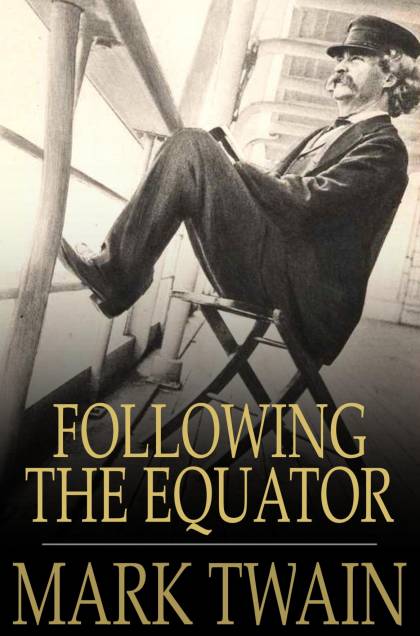 Book Summary: This is an illustrated copy of Following the Equator. Following the Equator is the 1897 travelogue by the famous American author Mark Twain. Twain wrote the book about a tour he took of the British Empire in 1895 in order to pay for a substantial debt he owed on a failed investment of the typesetting machine.
Book Summary: This is an illustrated copy of Following the Equator. Following the Equator is the 1897 travelogue by the famous American author Mark Twain. Twain wrote the book about a tour he took of the British Empire in 1895 in order to pay for a substantial debt he owed on a failed investment of the typesetting machine.
Odin’s Library Classics is dedicated to bringing the world the best of humankind’s literature from throughout the ages. Carefully selected, each work is unabridged from classic works of fiction, nonfiction, poetry, or drama.
- Book Reviews:
39) How to Tell a Story and Other Essays – 1897
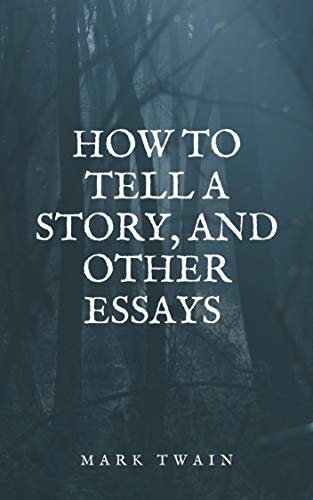 Book Summary: Is a series of essays by Mark Twain. In them, he describes his own writing style, attacks the idiocy of a fellow author, defends the virtue of a dead woman, and tries to protect ordinary citizens from insults by railroad conductors. The essays contained include How to Tell a Story, The Wounded Soldier, The Golden Arm, Mental Telegraphy Again, and The Invalid’s Story.
Book Summary: Is a series of essays by Mark Twain. In them, he describes his own writing style, attacks the idiocy of a fellow author, defends the virtue of a dead woman, and tries to protect ordinary citizens from insults by railroad conductors. The essays contained include How to Tell a Story, The Wounded Soldier, The Golden Arm, Mental Telegraphy Again, and The Invalid’s Story.
- Book Reviews:
40) Stirring Times in Austria – 1898
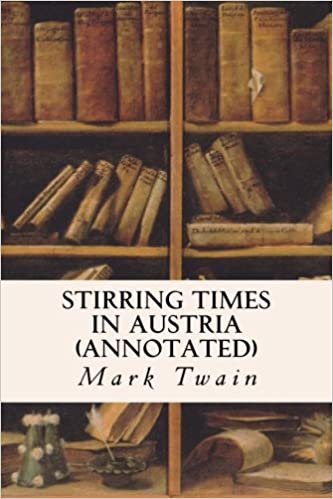 Book Summary: Stirring Times in Austria is a classic historical essay by Mark Twain. Here in Vienna in these closing days of 1897 one’s blood gets no chance to stagnate. The atmosphere is brimful of political electricity. All conversation is political; every man is a battery, with brushes over-worn, and gives out blue sparks when you set him going on the common topic. Everybody has an opinion, and lets you have it frank and hot, and out of this multitude of counsel you get merely confusion and despair. For no one really understands this political situation, or can tell you what is going to be the outcome of it.
Book Summary: Stirring Times in Austria is a classic historical essay by Mark Twain. Here in Vienna in these closing days of 1897 one’s blood gets no chance to stagnate. The atmosphere is brimful of political electricity. All conversation is political; every man is a battery, with brushes over-worn, and gives out blue sparks when you set him going on the common topic. Everybody has an opinion, and lets you have it frank and hot, and out of this multitude of counsel you get merely confusion and despair. For no one really understands this political situation, or can tell you what is going to be the outcome of it.
- Book Reviews:
41) Concerning the Jews – 1899
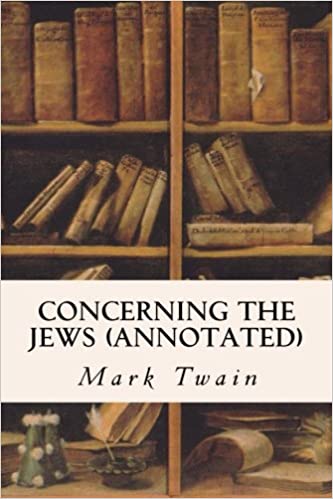 Book Summary: Some months ago I published a magazine article descriptive of a remarkable scene in the Imperial Parliament in Vienna. Since then I have received from Jews in America several letters of inquiry. They were difficult letters to answer, for they were not very definite. But at last I have received a definite one. It is from a lawyer, and he really asks the questions which the other writers probably believed they were asking.
Book Summary: Some months ago I published a magazine article descriptive of a remarkable scene in the Imperial Parliament in Vienna. Since then I have received from Jews in America several letters of inquiry. They were difficult letters to answer, for they were not very definite. But at last I have received a definite one. It is from a lawyer, and he really asks the questions which the other writers probably believed they were asking.
- Book Reviews:
42) The Man That Corrupted Hadleyburg – 1899
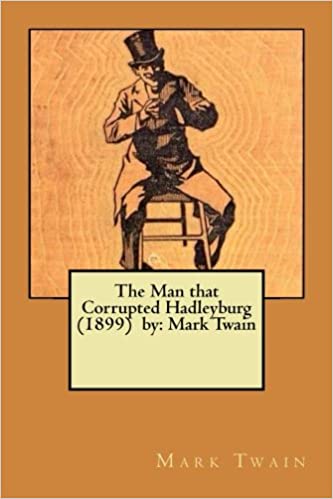 Book Summary: The short story “The Man That Corrupted Hadleyburg” was released in 1900 in a collection of the same name which also contained 14 other short stories previously published in periodicals. They all showcase Twain’s great satirical wit. The title story was meant to retell the Garden of Eden story in a modern setting. The supposedly “incorruptible” town of Hadleyburg offends a stranger who seeks revenge by attempting to corrupt the town.
Book Summary: The short story “The Man That Corrupted Hadleyburg” was released in 1900 in a collection of the same name which also contained 14 other short stories previously published in periodicals. They all showcase Twain’s great satirical wit. The title story was meant to retell the Garden of Eden story in a modern setting. The supposedly “incorruptible” town of Hadleyburg offends a stranger who seeks revenge by attempting to corrupt the town.
- Book Reviews:
43) Extracts from Adam’s Diary – 1901
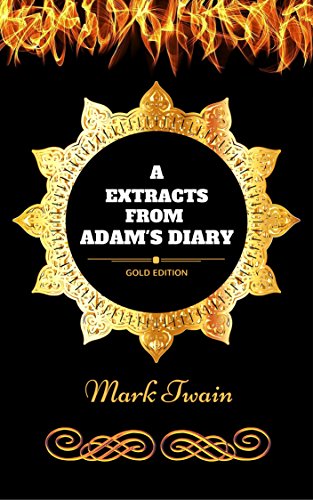 Book Summary: About Extracts from Adam’s Diary by Mark Twain
Book Summary: About Extracts from Adam’s Diary by Mark Twain
“Extracts from Adam’s Diary” is a 1904 comic short story by American humorist and writer Mark Twain. Adam (based on Twain himself) describes how Eve (modeled after his wife Livy) gets introduced into the Garden of Eden, and how he has to deal with “this new creature with the long hair” The piece gives a humorous account of Genesis. It begins with the introduction of Eve, described as an annoying creature with a penchant for naming things, which Adam could do without. It moves on to detail Eve eating the apple and finding Cain, a perplexing creature which Adam can not figure out. He devotes his ironically scientific mind to demystifying Cain’s species, thinking it a fish, then a kangaroo, then a bear. Eventually he figures out it is a human, like himself.
The work is humorous and ironic, and gives a new spin on Genesis: few people have considered what life must have been like for Adam, who is discovering everything anew; the work does not consider God’s role at all; and eventually, despite his initial deep annoyance with Eve, Adam finds himself in love with her.
- Book Reviews:
44) To the Person Sitting in Darkness – 1901
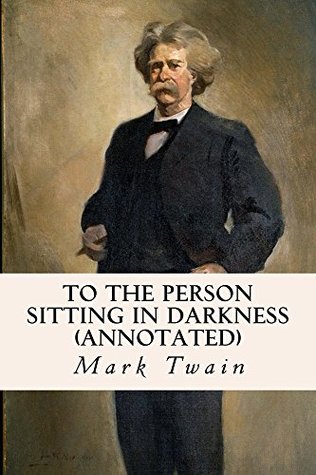 Book Summary: “To the Person Sitting in Darkness” is an essay by Mark Twain published in 1901. It is a satire of the Philippine-American War expressing Twain’s anti-Imperialist views.
Book Summary: “To the Person Sitting in Darkness” is an essay by Mark Twain published in 1901. It is a satire of the Philippine-American War expressing Twain’s anti-Imperialist views.
- Book Reviews:
45) A Double Barrelled Detective Story – 1902
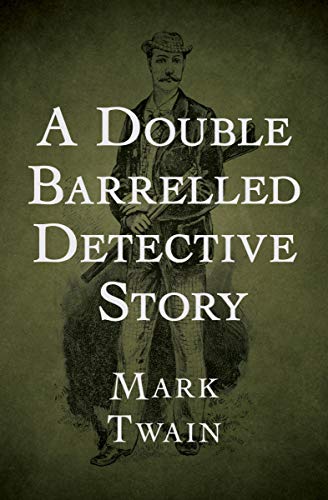 Book Summary: A Double Barrelled Detective Story
Book Summary: A Double Barrelled Detective Story
Mark Twain
1902- A Double Barreled Detective Story is a short story/novelette by Mark Twain (Samuel Clemens), in which Sherlock Holmes finds himself in the American west.
- Summary
- The story contains two arcs of revenges. In the primary arc, a rich young woman is abused, humiliated and abandoned by her new husband, Jacob Fuller, whom she married against the wishes of her father. The young Fuller resents her father’s rejection and dismissal of him as a neer-do-well and resolves to exact his revenge by mis-treating his new bride. After his abandonment, she bears a son who she names Archy Stillman. When the child gets older, the mother discovers that he possesses an incredible ability of smell, like a bloodhound. The mother instructs her child, now sixteen, to seek out his biological father with the intent of destroying that man’s peace and reputation, and hence extracting satisfaction for her.
- Five years later in a second arc, at a mining camp in California, Fetlock Jones, a nephew of Sherlock Holmes, kills his master Flint Buckner, a silver-miner, by blowing up his cabin. Since this occurs when Holmes happens to be visiting, Holmes applies his skills to bear upon the case and derives a logically worked conclusion that is proved to be abysmally wrong by Archy Stillman using his sense of smell. This could be seenas yet another piece where Twain tried to prove that life does not quite follow logic.
- This is a satire by Twain on the mystery novel genre. In the second arc, Sherlock Holmes is depicted in employing “scientific methods” to a ridiculous degree, yet arriving at a completely wrong assessment. On the other hand, the crime is solved with a supernatural ability that no normal human possesses. Yet even this fails to reveal the whole truth as the final twist of the story indicates.
- Furthermore, Sam Clemens/Mark Twain poked through the “4th wall” and appeared as himself in the middle of the story, supposedly while the story was being serialized, and responded to letters sent in by readers to the newspaper editor. During the exchange, Twain made fun of/self-advertised on some of his other
- Book Reviews:
46) A Dog’s Tale – 1903
- Book Reviews:
47) King Leopold’s Soliloquy – 1905
 Book Summary: “Darkly hilarious.” -The Cruel Radiance: Photography and Political Violence (2012)
Book Summary: “Darkly hilarious.” -The Cruel Radiance: Photography and Political Violence (2012)
“Twain’s input to the Congo agitation…was widely cited by the reformers in Britain…because of the fame of its author.” -Travel Writing and Atrocities (2010)
“A slender pamphlet about the colonial genocide…King Leopold—Twain’s satirical version of him—mocks the Yankees.” -Huck Finn’s America (2014)
“Imperialism and tyranny for Twain were great evils.” -The Last Empire (2002)Samuel Langhorne Clemens (1835 – 1910), better known by his pen name Mark Twain, was an American author and humorist.King Leopold’s Soliloquy is a 1905 pamphlet by Mark Twain. Its subject is King Leopold’s rule over the Congo Free State. A work of political satire harshly condemnatory of his actions, it ostensibly recounts Leopold speaking in his own defense.King Leopold raves madly about the good things that he says he has done for the people of the Congo Free State, including the disbursement of millions on religion and art. He says he had come to Congo with piety “oozing” from “every pore,” that he had only wanted to convert the people to Christianity, that he had wanted to stop the slave trade.Leopold says that he did not take any of the government money, that he did not use the revenues as his personal “swag”, and that such claims by the “meddlesome American missionaries”, “frank British consuls”, and “blabbing Belgian-born traitors” are wholly false. He asserts that for a King to be criticized as he has been is blasphemy — surely, under the rule of God, any King who was not doing God’s will would not have been helped by God.The book mentions the critical report by the missionary William Henry Sheppard on an 1899 massacre of over eighty people by Zappo Zaps sent to collect taxes.[1] Leopold claims that his critics only speak of what is unfavorable to him, such as the unfair taxes that he levied upon the people of the Congo, which caused starvation and the extermination of entire villages, but not of the fact that he had sent missionaries to the villages to convert them to Christianity. Nothing, Leopold complains, can satisfy the English.The book was published in English, French, German and Italian.
- Book Reviews:
48) Eve’s Diary – 1905
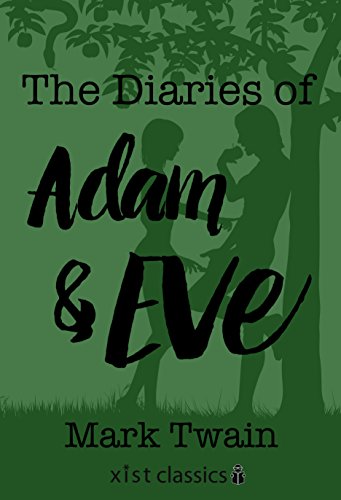 Book Summary: What if Adam and Eve Had a Diary?“He talks very little. Perhaps it is because he is not bright and is sensitive about it and wishes to conceal it. It is such a pity that he should feel so, for brightness is nothing. It is in the heart that the values lie. I wish I could make him understand that a loving good heart is riches, and riches is enough, and that without it intellect is poverty.” – Mark Twain, Eve’s DiaryMark Twain’s short stories aren’t about his religious beliefs. In fact, the Diaries of Adam and Eve should be taken with a grain of salt as they are humorous and witty and describe in a unique way the relationship between two human beings, man and woman who eventually end up falling in love with each other.Xist Publishing is a digital-first publisher. Xist Publishing creates books for the touchscreen generation and is dedicated to helping everyone develop a lifetime love of reading, no matter what form it takes
Book Summary: What if Adam and Eve Had a Diary?“He talks very little. Perhaps it is because he is not bright and is sensitive about it and wishes to conceal it. It is such a pity that he should feel so, for brightness is nothing. It is in the heart that the values lie. I wish I could make him understand that a loving good heart is riches, and riches is enough, and that without it intellect is poverty.” – Mark Twain, Eve’s DiaryMark Twain’s short stories aren’t about his religious beliefs. In fact, the Diaries of Adam and Eve should be taken with a grain of salt as they are humorous and witty and describe in a unique way the relationship between two human beings, man and woman who eventually end up falling in love with each other.Xist Publishing is a digital-first publisher. Xist Publishing creates books for the touchscreen generation and is dedicated to helping everyone develop a lifetime love of reading, no matter what form it takes
- Get your next Xist Classic title for Kindle here: http://amzn.to/1A7cKKl
- Find all our our books for Kindle here: http://amzn.to/1PooxLl
- Sign up for the Xist Publishing Newsletter here.
Find more great titles on our website.
- Book Reviews:
49) Autobiography of Mark Twain – 1906
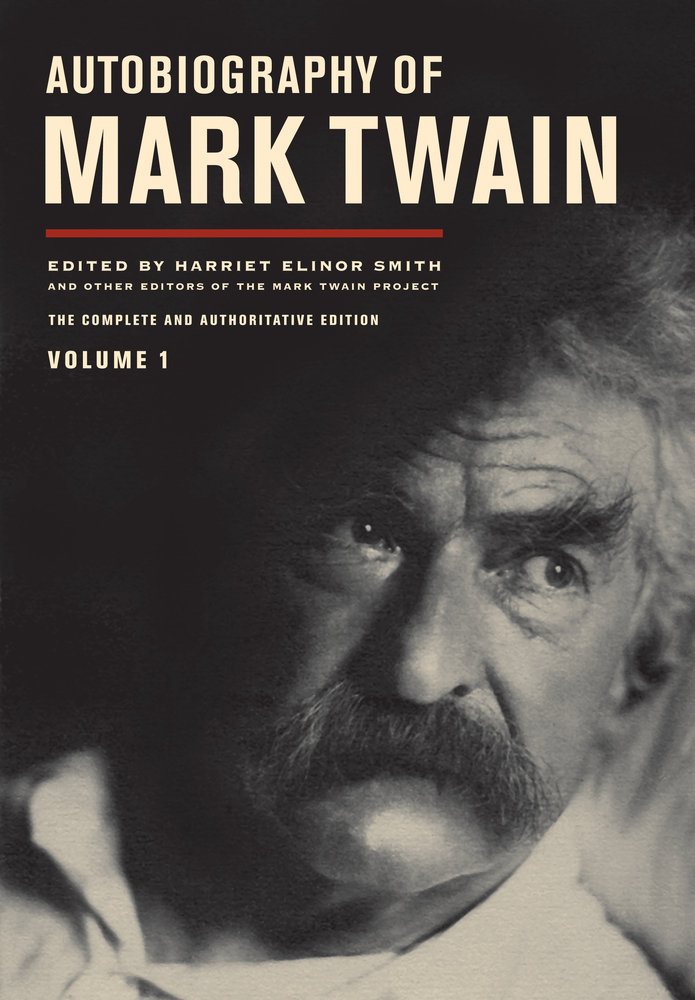 Book Summary: “I’ve struck it!” Mark Twain wrote in a 1904 letter to a friend. “And I will give it away – to you. You will never know how much enjoyment you have lost until you get to dictating your autobiography.”Thus, after dozens of false starts and hundreds of pages, Twain embarked on his “Final (and Right) Plan” for telling the story of his life. His innovative notion – to “talk only about the thing which interests you for the moment” – meant that his thoughts could range freely. The strict instruction that many of these texts remain unpublished for 100 years meant that when they came out, he would be “dead, and unaware, and indifferent” and that he was therefore free to speak his “whole frank mind”.The year 2010 marks the 100th anniversary of Twain’s death. In celebration of this important milestone, here, for the first time, is Mark Twain’s uncensored autobiography, in its entirety, exactly as he left it. This major literary event offers the first of three volumes and presents Mark Twain’s authentic and unsuppressed voice, brimming with humor, ideas, and opinions, and speaking clearly from the grave, as he intended.Edited by Harriet Elinor Smith and other editors of the Mark Twain Project.Mark Twain (1835 – 1910) was born Samuel L. Clemens in the town of Florida, Missouri. One of the most popular and influential authors our nation has ever produced, his keen wit and incisive satire earned him praise from both critics and peers. He has been called not only the greatest humorist of his age but the father of American literature.
Book Summary: “I’ve struck it!” Mark Twain wrote in a 1904 letter to a friend. “And I will give it away – to you. You will never know how much enjoyment you have lost until you get to dictating your autobiography.”Thus, after dozens of false starts and hundreds of pages, Twain embarked on his “Final (and Right) Plan” for telling the story of his life. His innovative notion – to “talk only about the thing which interests you for the moment” – meant that his thoughts could range freely. The strict instruction that many of these texts remain unpublished for 100 years meant that when they came out, he would be “dead, and unaware, and indifferent” and that he was therefore free to speak his “whole frank mind”.The year 2010 marks the 100th anniversary of Twain’s death. In celebration of this important milestone, here, for the first time, is Mark Twain’s uncensored autobiography, in its entirety, exactly as he left it. This major literary event offers the first of three volumes and presents Mark Twain’s authentic and unsuppressed voice, brimming with humor, ideas, and opinions, and speaking clearly from the grave, as he intended.Edited by Harriet Elinor Smith and other editors of the Mark Twain Project.Mark Twain (1835 – 1910) was born Samuel L. Clemens in the town of Florida, Missouri. One of the most popular and influential authors our nation has ever produced, his keen wit and incisive satire earned him praise from both critics and peers. He has been called not only the greatest humorist of his age but the father of American literature.
- Book Reviews:
50) What Is Man? – 1906
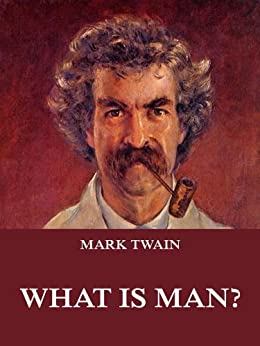 Book Summary: This volume includes the most important essays by American novelist and writer Mark Twain. Headlined by “What Is Man?”, his fictional dialogue regarding the nature of man, there are also the followings works included:The Death Of Jean
Book Summary: This volume includes the most important essays by American novelist and writer Mark Twain. Headlined by “What Is Man?”, his fictional dialogue regarding the nature of man, there are also the followings works included:The Death Of Jean
The Turning-Point Of My Life
How To Make History Dates Stick
The Memorable Assassination
A Scrap Of Curious History
Switzerland, The Cradle Of Liberty
At The Shrine Of St. Wagner
William Dean Howells
English As She Is Taught
A Simplified Alphabet
As Concerns Interpreting The Deity
Concerning Tobacco
The Bee
Taming The Bicycle
Is Shakespeare Dead?
- Book Reviews:
51) The $30,000 Bequest and Other Stories – 1906
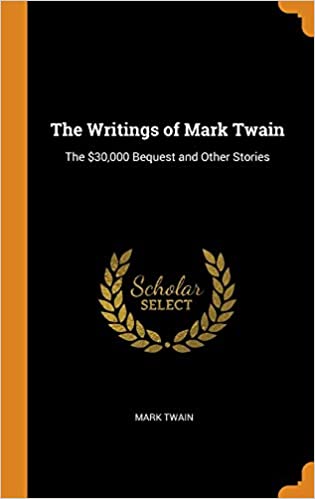 Book Summary: This work has been selected by scholars as being culturally important and is part of the knowledge base of civilization as we know it.This work is in the public domain in the United States of America, and possibly other nations. Within the United States, you may freely copy and distribute this work, as no entity (individual or corporate) has a copyright on the body of the work.Scholars believe, and we concur, that this work is important enough to be preserved, reproduced, and made generally available to the public. To ensure a quality reading experience, this work has been proofread and republished using a format that seamlessly blends the original graphical elements with text in an easy-to-read typeface.We appreciate your support of the preservation process, and thank you for being an important part of keeping this knowledge alive and relevant.
Book Summary: This work has been selected by scholars as being culturally important and is part of the knowledge base of civilization as we know it.This work is in the public domain in the United States of America, and possibly other nations. Within the United States, you may freely copy and distribute this work, as no entity (individual or corporate) has a copyright on the body of the work.Scholars believe, and we concur, that this work is important enough to be preserved, reproduced, and made generally available to the public. To ensure a quality reading experience, this work has been proofread and republished using a format that seamlessly blends the original graphical elements with text in an easy-to-read typeface.We appreciate your support of the preservation process, and thank you for being an important part of keeping this knowledge alive and relevant.
- Book Reviews:
52) A Horse’s Tale – 1906
 Book Summary: A Horse’s Tale is a novel by Mark Twain (Samuel Clemens), written partially in the voice of Soldier Boy, who is Buffalo Bill’s favorite horse, at a fictional frontier outpost with the U.S. 7th Cavalry. With a fanciful mix of points of view, we hear the story of Cathy and her relationship with Soldier Boy and the soldiers of the 7th Cavalry. A surprisingly graphic depiction of a Spanish bullfight leaves no doubt where Mark Twain’s sympathies lie.
Book Summary: A Horse’s Tale is a novel by Mark Twain (Samuel Clemens), written partially in the voice of Soldier Boy, who is Buffalo Bill’s favorite horse, at a fictional frontier outpost with the U.S. 7th Cavalry. With a fanciful mix of points of view, we hear the story of Cathy and her relationship with Soldier Boy and the soldiers of the 7th Cavalry. A surprisingly graphic depiction of a Spanish bullfight leaves no doubt where Mark Twain’s sympathies lie.
- Book Reviews:
53) Hunting the Deceitful Turkey – 1906
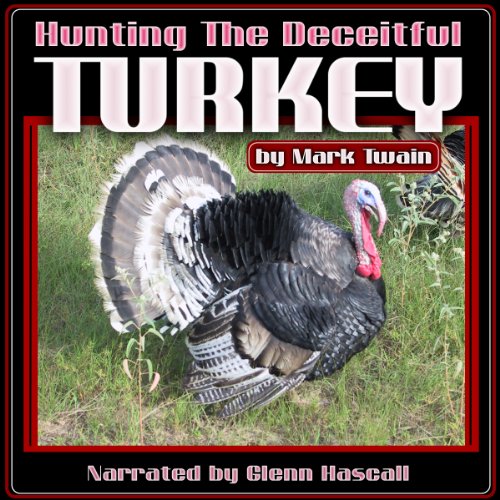 Book Summary: When Mark Twain reflects on childhood you can be certain humor will follow. Such is the case with a young boy and an attempt to capture a turkey bare handed. You may wonder if you should sympathize with the turkey – or the boy.
Book Summary: When Mark Twain reflects on childhood you can be certain humor will follow. Such is the case with a young boy and an attempt to capture a turkey bare handed. You may wonder if you should sympathize with the turkey – or the boy.
- Book Reviews:
54) Christian Science – 1907
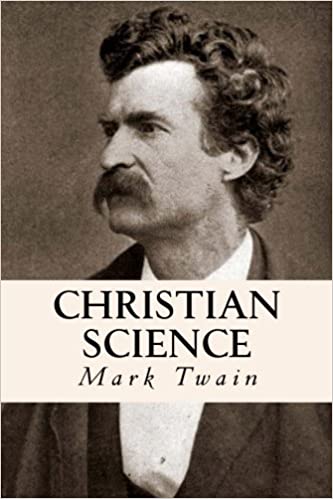 Book Summary: Christian Science is a classic religious studies essay by Mark Twain. Christian Science is a set of beliefs and practices belonging to the metaphysical family of new religious movements It was developed in 19th-century New England by Mary Baker Eddy (1821–1910), who argued in her book Science and Health (1875) that sickness is an illusion that can be corrected by prayer alone. The book became Christian Science’s central text, along with the Bible, and by 2001 had sold ten million copies in 16 languages.Twain’s first article about Christian Science was published in Cosmopolitan in 1899. A humorous work of fiction, it describes how he fell over a cliff while walking in Austria, breaking several bones. A Christian Science practitioner who lived nearby was sent for, but could not attend immediately and so undertook to provide an “absent healing.” She sent a message asking Twain to wait overnight and to remember that there was nothing wrong with him:I thought there must be some mistake.”Did you tell her I walked off a cliff seventy-five feet high?””Yes.””And struck a boulder at the bottom and bounced?””Yes.””And struck another one and bounced again?””Yes.””And struck another one and bounced yet again?””Yes.””And broke the boulders?””Yes.””That accounts for it; she is thinking of the boulders. Why didn’t you tell her I got hurt, too?”[2]In the third chapter of this story (as published in the book form described below), Twain estimates more than 120 fractures, some or many of which were visible to him, as well as 7 dislocated joints, including his hips, shoulders, knees and neck. All of these were healed within three hours of the “Christian Science doctor’s” visit of the second day of the story. Immediately following this healing, he turns to the local country horse doctor to cure a headache and stomach ache.In 1907 he collected this and several other critical articles he had written and published them as a book, Christian Science. Twain himself believed that mind could influence matter to some degree. He nevertheless took strong exception to the writings of Eddy, calling them “incomprehensible and uninterpretable.” He was particularly incensed by the thought that Eddy was using Christian Science to accrue wealth and power for herself.Gillian Gill, a biographer of Mary Baker Eddy, has argued that Twain was “ambivalent” towards Christian Science, and that passages of the essay were in fact “pretty unambiguously pro-CS.” In response Caroline Fraser writes that Gill has misread the text, and that Twain praised Christian Science “in the most backhanded and ironic way.” Fraser writes that whatever Twain’s view of Christian Science, his view of Eddy herself was overwhelmingly hostile. He called her “[g]rasping, sordid, penurious, famishing for everything she sees—money, power, glory—vain, untruthful, jealous, despotic, arrogant, insolent, pitiless where thinkers and hypnotists are concerned, illiterate, shallow, incapable of reasoning outside of commercial lines, immeasurably selfish.
Book Summary: Christian Science is a classic religious studies essay by Mark Twain. Christian Science is a set of beliefs and practices belonging to the metaphysical family of new religious movements It was developed in 19th-century New England by Mary Baker Eddy (1821–1910), who argued in her book Science and Health (1875) that sickness is an illusion that can be corrected by prayer alone. The book became Christian Science’s central text, along with the Bible, and by 2001 had sold ten million copies in 16 languages.Twain’s first article about Christian Science was published in Cosmopolitan in 1899. A humorous work of fiction, it describes how he fell over a cliff while walking in Austria, breaking several bones. A Christian Science practitioner who lived nearby was sent for, but could not attend immediately and so undertook to provide an “absent healing.” She sent a message asking Twain to wait overnight and to remember that there was nothing wrong with him:I thought there must be some mistake.”Did you tell her I walked off a cliff seventy-five feet high?””Yes.””And struck a boulder at the bottom and bounced?””Yes.””And struck another one and bounced again?””Yes.””And struck another one and bounced yet again?””Yes.””And broke the boulders?””Yes.””That accounts for it; she is thinking of the boulders. Why didn’t you tell her I got hurt, too?”[2]In the third chapter of this story (as published in the book form described below), Twain estimates more than 120 fractures, some or many of which were visible to him, as well as 7 dislocated joints, including his hips, shoulders, knees and neck. All of these were healed within three hours of the “Christian Science doctor’s” visit of the second day of the story. Immediately following this healing, he turns to the local country horse doctor to cure a headache and stomach ache.In 1907 he collected this and several other critical articles he had written and published them as a book, Christian Science. Twain himself believed that mind could influence matter to some degree. He nevertheless took strong exception to the writings of Eddy, calling them “incomprehensible and uninterpretable.” He was particularly incensed by the thought that Eddy was using Christian Science to accrue wealth and power for herself.Gillian Gill, a biographer of Mary Baker Eddy, has argued that Twain was “ambivalent” towards Christian Science, and that passages of the essay were in fact “pretty unambiguously pro-CS.” In response Caroline Fraser writes that Gill has misread the text, and that Twain praised Christian Science “in the most backhanded and ironic way.” Fraser writes that whatever Twain’s view of Christian Science, his view of Eddy herself was overwhelmingly hostile. He called her “[g]rasping, sordid, penurious, famishing for everything she sees—money, power, glory—vain, untruthful, jealous, despotic, arrogant, insolent, pitiless where thinkers and hypnotists are concerned, illiterate, shallow, incapable of reasoning outside of commercial lines, immeasurably selfish.
- Book Reviews:
55) A Double Barrelled Detective Story – 1907
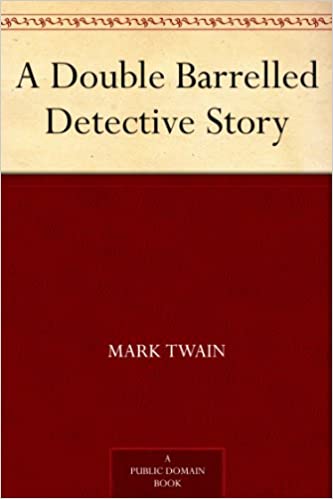 Book Summary: A Double Barrelled Detective Story
Book Summary: A Double Barrelled Detective Story
Mark Twain
1902- A Double Barreled Detective Story is a short story/novelette by Mark Twain (Samuel Clemens), in which Sherlock Holmes finds himself in the American west.
- Summary
- The story contains two arcs of revenges. In the primary arc, a rich young woman is abused, humiliated and abandoned by her new husband, Jacob Fuller, whom she married against the wishes of her father. The young Fuller resents her father’s rejection and dismissal of him as a neer-do-well and resolves to exact his revenge by mis-treating his new bride. After his abandonment, she bears a son who she names Archy Stillman. When the child gets older, the mother discovers that he possesses an incredible ability of smell, like a bloodhound. The mother instructs her child, now sixteen, to seek out his biological father with the intent of destroying that man’s peace and reputation, and hence extracting satisfaction for her.
- Five years later in a second arc, at a mining camp in California, Fetlock Jones, a nephew of Sherlock Holmes, kills his master Flint Buckner, a silver-miner, by blowing up his cabin. Since this occurs when Holmes happens to be visiting, Holmes applies his skills to bear upon the case and derives a logically worked conclusion that is proved to be abysmally wrong by Archy Stillman using his sense of smell. This could be seenas yet another piece where Twain tried to prove that life does not quite follow logic.
- This is a satire by Twain on the mystery novel genre. In the second arc, Sherlock Holmes is depicted in employing “scientific methods” to a ridiculous degree, yet arriving at a completely wrong assessment. On the other hand, the crime is solved with a supernatural ability that no normal human possesses. Yet even this fails to reveal the whole truth as the final twist of the story indicates.
- Furthermore, Sam Clemens/Mark Twain poked through the “4th wall” and appeared as himself in the middle of the story, supposedly while the story was being serialized, and responded to letters sent in by readers to the newspaper editor. During the exchange, Twain made fun of/self-advertised on some of his other
- Book Reviews:
56) Captain Stormfield’s Visit to Heaven – 1909
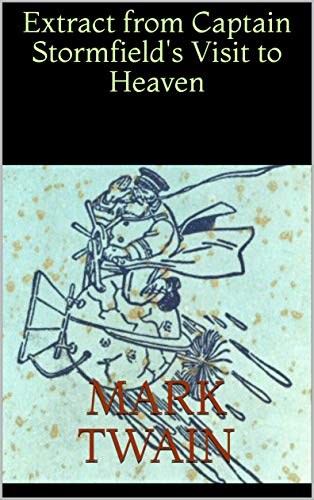 Book Summary: “Captain Stormfield’s Visit to Heaven” is a short story written by American writer Mark Twain. It first appeared in print in Harper’s Magazine in December 1907 and January 1908, and was published in book form with some revisions in 1909. This was the last story published by Twain during his life.
Book Summary: “Captain Stormfield’s Visit to Heaven” is a short story written by American writer Mark Twain. It first appeared in print in Harper’s Magazine in December 1907 and January 1908, and was published in book form with some revisions in 1909. This was the last story published by Twain during his life.
- Book Reviews:
57) Is Shakespeare Dead? – 1909
 Book Summary: 1601, or Conversation, as it was by the Social Fireside, in the time of the Tudors is a hilarious ribald send-up of Elizabethan England in which Queen Elizabeth, Shakespeare, Ben Jonson, Sir Walter Raleigh, and other luminaries of the period are pictured sitting about the fireplace amusing one another with risqué tales. During a visit to West Point in 1881, Twain met Lieutenant Charles Erskine Scott Wood, adjutant to the commanding general. As Leslie Fiedler notes in his afterword, “he discovered not only that Wood, like him, was a freethinker, but that he had at his disposal a well-equipped printing plant.” He asked Wood to publish the piece, and it is the West Point edition–complete with the Old English-style type Wood selected–that is printed here.
Book Summary: 1601, or Conversation, as it was by the Social Fireside, in the time of the Tudors is a hilarious ribald send-up of Elizabethan England in which Queen Elizabeth, Shakespeare, Ben Jonson, Sir Walter Raleigh, and other luminaries of the period are pictured sitting about the fireplace amusing one another with risqué tales. During a visit to West Point in 1881, Twain met Lieutenant Charles Erskine Scott Wood, adjutant to the commanding general. As Leslie Fiedler notes in his afterword, “he discovered not only that Wood, like him, was a freethinker, but that he had at his disposal a well-equipped printing plant.” He asked Wood to publish the piece, and it is the West Point edition–complete with the Old English-style type Wood selected–that is printed here.
If “in 1601 Twain both parodied and paid homage to Shakespeare’s liberating bawdry,” Erica Jong observes in her introduction, in “Is Shakespeare Dead? he tried to come to terms with his conflicting responses to Shakespeare as mentor and muse.” Jong suggests that Twain’s real concern in this book may well be his own “place in literary history.”
- Book Reviews:
58) Speeches – 1910
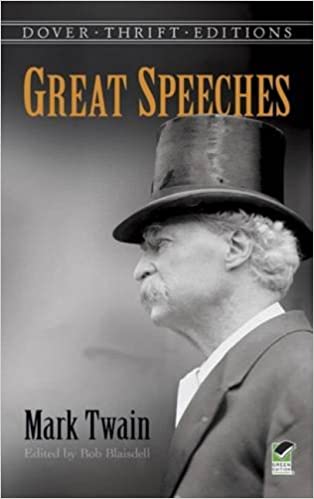 Book Summary: American novelist and humorist Mark Twain was a captivating public speaker, and this affordable volume brings together a generous selection of his best speeches. Contents include his famous 70th birthday address, delivered at a 1905 gala; his classic oration on “Plymouth Rock and the Pilgrims”; and the perennial favorite, “Horrors of the German Language.”
Book Summary: American novelist and humorist Mark Twain was a captivating public speaker, and this affordable volume brings together a generous selection of his best speeches. Contents include his famous 70th birthday address, delivered at a 1905 gala; his classic oration on “Plymouth Rock and the Pilgrims”; and the perennial favorite, “Horrors of the German Language.”
- Book Reviews:
59) My Platonic Sweetheart – 1912
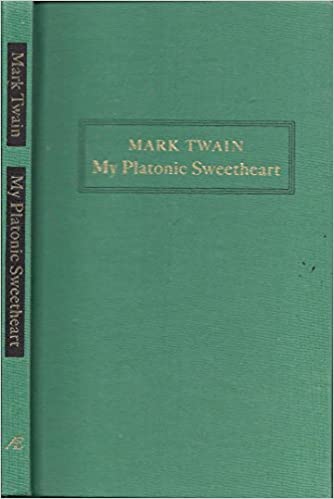 Book Summary: Pristine copy published by Reincarnation Library with their old world quality book publishing. Bought new, carefully kept in private library. Gift quality.
Book Summary: Pristine copy published by Reincarnation Library with their old world quality book publishing. Bought new, carefully kept in private library. Gift quality.
- Book Reviews:
60) The Mysterious Stranger – 1916
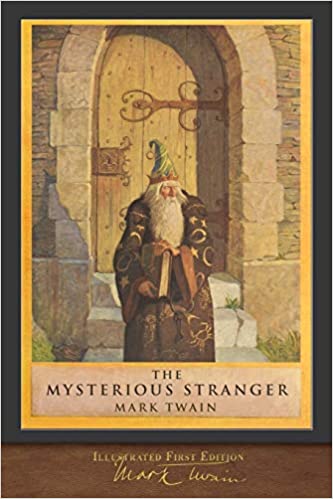 Book Summary: The Mysterious Stranger is a novel by the American author Mark Twain that he worked on for a number of years between 1897 and 1908. This final version was published in 1916 after his death. The story takes place in 1590, where three boys, Theodor, Seppi, and Nikolaus, live relatively happy simple lives in a remote Austrian village called Eseldorf (German for “Assville” or “Donkeytown”). The story is narrated by Theodor, the village organist’s son. This edition also contains three other Twain stories: “A Fable”, “Hunting the Deceitful Turkey”, and “The McWilliamses and the Burglar Alarm.”
Book Summary: The Mysterious Stranger is a novel by the American author Mark Twain that he worked on for a number of years between 1897 and 1908. This final version was published in 1916 after his death. The story takes place in 1590, where three boys, Theodor, Seppi, and Nikolaus, live relatively happy simple lives in a remote Austrian village called Eseldorf (German for “Assville” or “Donkeytown”). The story is narrated by Theodor, the village organist’s son. This edition also contains three other Twain stories: “A Fable”, “Hunting the Deceitful Turkey”, and “The McWilliamses and the Burglar Alarm.”
- Book Reviews:
61) The War Prayer – 1916
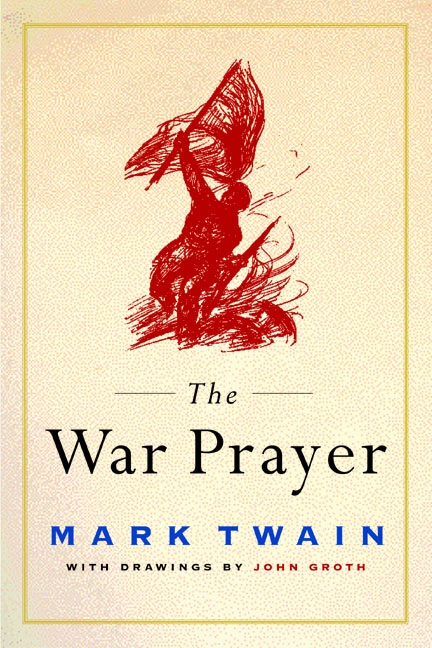 Book Summary: Written by Mark Twain during the Philippine-American War in the first decade of the twentieth century, The War Prayer tells of a patriotic church service held to send the town’s young men off to war. During the service, a stranger enters and addresses the gathering. He tells the patriotic crowd that their prayers for victory are double-edged-by praying for victory they are also praying for the destruction of the enemy… for the destruction of human life.Originally rejected for publication in 1905 as “not quite suited to a woman’s magazine,” this antiwar parable remained unpublished until 1923, when Twain’s literary executor collected it in the volume Europe and Elsewhere. Handsomely illustrated by the artist and war correspondent Philip Groth, The War Prayer remains a relevant classic by an American icon.
Book Summary: Written by Mark Twain during the Philippine-American War in the first decade of the twentieth century, The War Prayer tells of a patriotic church service held to send the town’s young men off to war. During the service, a stranger enters and addresses the gathering. He tells the patriotic crowd that their prayers for victory are double-edged-by praying for victory they are also praying for the destruction of the enemy… for the destruction of human life.Originally rejected for publication in 1905 as “not quite suited to a woman’s magazine,” this antiwar parable remained unpublished until 1923, when Twain’s literary executor collected it in the volume Europe and Elsewhere. Handsomely illustrated by the artist and war correspondent Philip Groth, The War Prayer remains a relevant classic by an American icon.
- Book Reviews:
62) Moments with Mark Twain – 1920
 Book Summary: This work has been selected by scholars as being culturally important, and is part of the knowledge base of civilization as we know it. This work was reproduced from the original artifact, and remains as true to the original work as possible. Therefore, you will see the original copyright references, library stamps (as most of these works have been housed in our most important libraries around the world), and other notations in the work.This work is in the public domain in the United States of America, and possibly other nations. Within the United States, you may freely copy and distribute this work, as no entity (individual or corporate) has a copyright on the body of the work.As a reproduction of a historical artifact, this work may contain missing or blurred pages, poor pictures, errant marks, etc. Scholars believe, and we concur, that this work is important enough to be preserved, reproduced, and made generally available to the public. We appreciate your support of the preservation process, and thank you for being an important part of keeping this knowledge alive and relevant.
Book Summary: This work has been selected by scholars as being culturally important, and is part of the knowledge base of civilization as we know it. This work was reproduced from the original artifact, and remains as true to the original work as possible. Therefore, you will see the original copyright references, library stamps (as most of these works have been housed in our most important libraries around the world), and other notations in the work.This work is in the public domain in the United States of America, and possibly other nations. Within the United States, you may freely copy and distribute this work, as no entity (individual or corporate) has a copyright on the body of the work.As a reproduction of a historical artifact, this work may contain missing or blurred pages, poor pictures, errant marks, etc. Scholars believe, and we concur, that this work is important enough to be preserved, reproduced, and made generally available to the public. We appreciate your support of the preservation process, and thank you for being an important part of keeping this knowledge alive and relevant.
- Book Reviews:
63) The Best American Humorous Short Stories – 1920
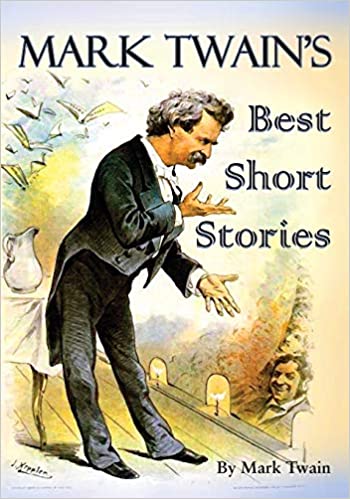 Book Summary: Samuel Langhorne Clemens (1835-1910), better known by his pen name Mark Twain, is the author of such classics as The Adventures of Tom Sawyer, The Adventures of Huckleberry Finn, and The Prince and the Pauper. He was born in Florida, Missouri and grew up along the Mississippi Valley. Although he left school at the age of 12 when his father died, he was eventually awarded honorary degrees from Yale University, the University of Missouri, and Oxford University. His career encompassed such varied occupations as printer, miner, Mississippi riverboat pilot, journalist, travel writer, novelist, and publisher. His vivid imagination, keen sense of humor, and sharp wit resulted in some of the most beloved classics of American literature.This book contains some of Clemens’ best loved short stories and essays, both humorous and thought provoking. Includes The Notorious Jumping Frog of Calaveras County. The Stolen White Elephant, A Dog’s Tale, and Extracts from Adam’s Diary, among others, illustrated.
Book Summary: Samuel Langhorne Clemens (1835-1910), better known by his pen name Mark Twain, is the author of such classics as The Adventures of Tom Sawyer, The Adventures of Huckleberry Finn, and The Prince and the Pauper. He was born in Florida, Missouri and grew up along the Mississippi Valley. Although he left school at the age of 12 when his father died, he was eventually awarded honorary degrees from Yale University, the University of Missouri, and Oxford University. His career encompassed such varied occupations as printer, miner, Mississippi riverboat pilot, journalist, travel writer, novelist, and publisher. His vivid imagination, keen sense of humor, and sharp wit resulted in some of the most beloved classics of American literature.This book contains some of Clemens’ best loved short stories and essays, both humorous and thought provoking. Includes The Notorious Jumping Frog of Calaveras County. The Stolen White Elephant, A Dog’s Tale, and Extracts from Adam’s Diary, among others, illustrated.
- Book Reviews:
64) Mark Twain’s notebook – 1933
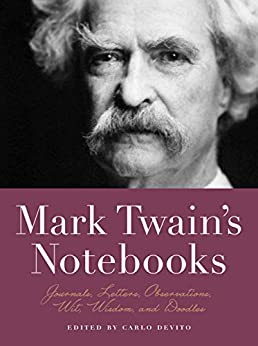 Book Summary: The original and insightful collection that combines Mark Twain’s journal writings with his rarely seen sketches and doodles. Fascinating and often hilarious, this is a complete record of the thoughts, ideas, and observations of the father of American literature.
Book Summary: The original and insightful collection that combines Mark Twain’s journal writings with his rarely seen sketches and doodles. Fascinating and often hilarious, this is a complete record of the thoughts, ideas, and observations of the father of American literature.
A national treasure and a cultural and literary icon, Mark Twain was called “the father of American literature” by William Faulkner. His beloved works include The Adventures of Huckleberry Finn, Tom Sawyer, and 26 other books. His inimitable prose seamlessly weaves together humor, insight, vivid details, and memorable characters. Along with these published works, Twain, who was also a journalist, produced approximately 40 to 50 pocket notebooks and wrote countless letters, essays, travelogues, and lectures in his lifetime.
Mark Twain’s Notebooks is the first collection to gather these writings and combine them with dozens of Twain’s rarely seen sketches, doodles, and diagrams, as well as facsimiles of his original journal pages, letters, and essays. The result is page after beautifully designed page of some of the best, yet little-known, writings of Mark Twain. Organized by topics such as science, literature, health, family life, and food, the collection also includes intimate letters that describe the home he built in Hartford, Connecticut; his travels across Europe, the Middle East, and the United States; and his agony over the death of his favorite daughter.The writing and art is selected by book and publishing veteran Carlo De Vito, who provides fascinating commentary and insights into the material throughout the book.
- Book Reviews:
65) A Murder, A Mystery and A Marriage – 1945
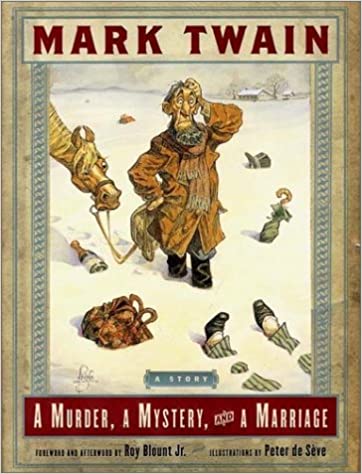 Book Summary: A previously unpublished story, originally written in 1876, chronicles the efforts of John Gray, a humble farmer in the mythical small town of Deer Lick, to marry off his daughter, Mary, to the heir to the town’s wealthiest family, but the sudden appearance of a mysterious stranger not only derails Gray’s plans but also leads to murder. First serial, Atlantic.
Book Summary: A previously unpublished story, originally written in 1876, chronicles the efforts of John Gray, a humble farmer in the mythical small town of Deer Lick, to marry off his daughter, Mary, to the heir to the town’s wealthiest family, but the sudden appearance of a mysterious stranger not only derails Gray’s plans but also leads to murder. First serial, Atlantic.
- Book Reviews:
66) Four Classic American Novels – 1960
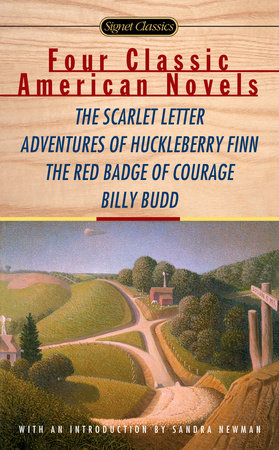 Book Summary: Shining examples of American literature at its best, these four novels explore timeless themes—adventure, war, sex, and morality—through compelling narratives. An adulteress, a runaway boy, a terrified soldier, and a maltreated sailor—the heroes of these novels have become a part of popular culture. This indispensable volume includes…The Scarlet Letter by Nathaniel Hawthorne
Book Summary: Shining examples of American literature at its best, these four novels explore timeless themes—adventure, war, sex, and morality—through compelling narratives. An adulteress, a runaway boy, a terrified soldier, and a maltreated sailor—the heroes of these novels have become a part of popular culture. This indispensable volume includes…The Scarlet Letter by Nathaniel Hawthorne
Adventures of Huckleberry Finn by Mark Twain
The Red Badge of Courage by Stephen Crane
Billy Budd by Herman MelvilleWith an Introduction by Sandra Newman
- Book Reviews:
67) Letters from the Earth – 1962
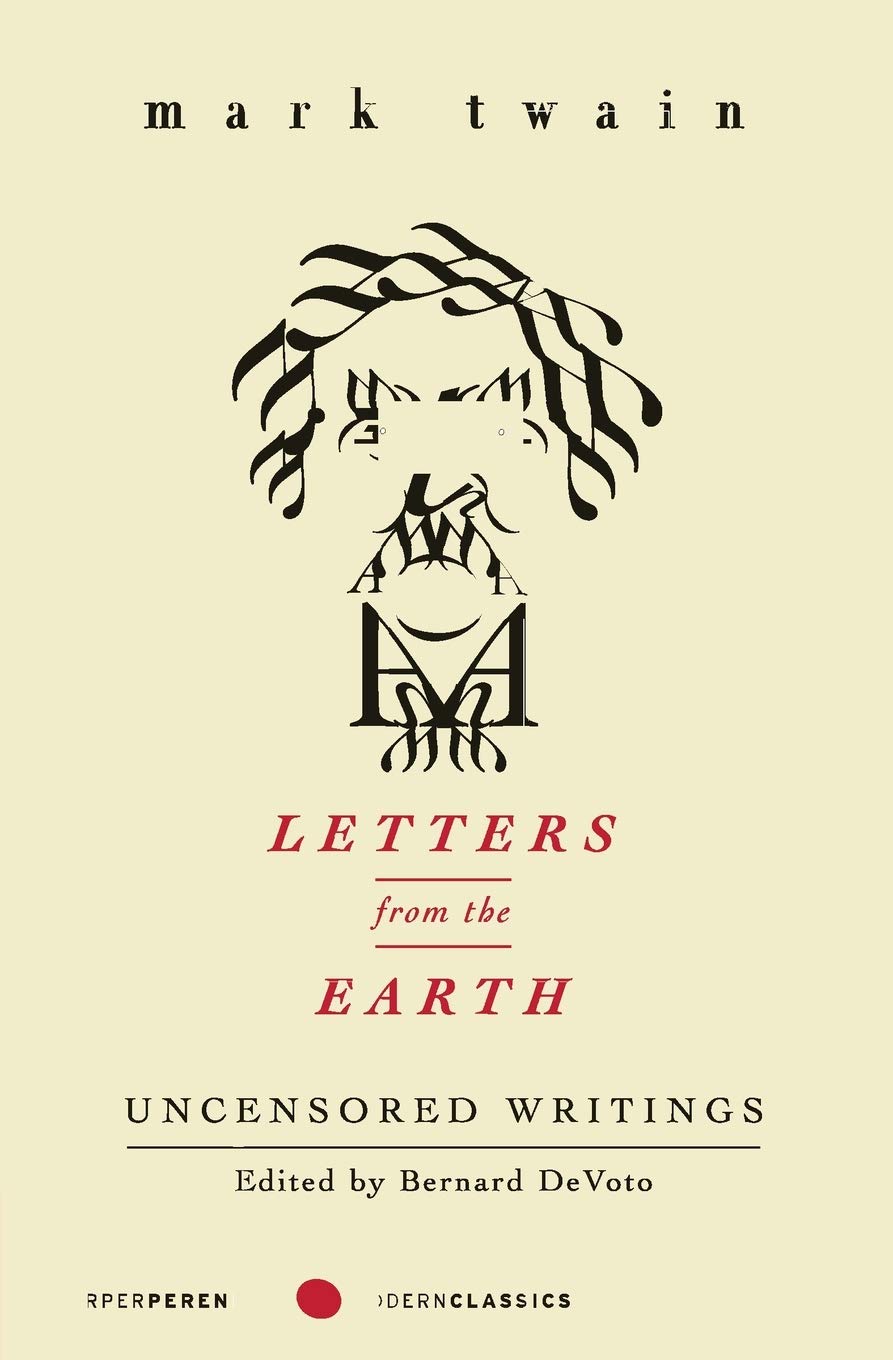 Book Summary: “The most impressive contribution to books by Mark Twain since The Mysterious Stranger of 1916…The attitude is that of Swift, the intellectual contempt is that of Voltaire, and the imagination is that of one of the great masters of American writing.”—New York Times Book ReviewVirtually none of the material in Letters from the Earth was published in Twain’s lifetime and the manuscript was only approved by his executors in 1962. This is vintage Twain—sharp, witty, imaginative, wildly funny. His voice is as vigorous and blistering as ever, capable of surprising truth and provoking laughter in the most unlikely places.In this collection, he presents himself as the Father of History, reviewing and interpreting events from the garden of Eden through the Fall and the Flood, translating the papers of Adam and his descendants down through the generations. There are comments on James Fenimore Cooper, English architecture, and the civilization of the French, as well as proposals for a simplified alphabet and a parody of books on etiquette. Letters from the Earth an exuberantly eclectic collection.
Book Summary: “The most impressive contribution to books by Mark Twain since The Mysterious Stranger of 1916…The attitude is that of Swift, the intellectual contempt is that of Voltaire, and the imagination is that of one of the great masters of American writing.”—New York Times Book ReviewVirtually none of the material in Letters from the Earth was published in Twain’s lifetime and the manuscript was only approved by his executors in 1962. This is vintage Twain—sharp, witty, imaginative, wildly funny. His voice is as vigorous and blistering as ever, capable of surprising truth and provoking laughter in the most unlikely places.In this collection, he presents himself as the Father of History, reviewing and interpreting events from the garden of Eden through the Fall and the Flood, translating the papers of Adam and his descendants down through the generations. There are comments on James Fenimore Cooper, English architecture, and the civilization of the French, as well as proposals for a simplified alphabet and a parody of books on etiquette. Letters from the Earth an exuberantly eclectic collection.
- Book Reviews:
68) Mark Twain’s San Francisco – 1963
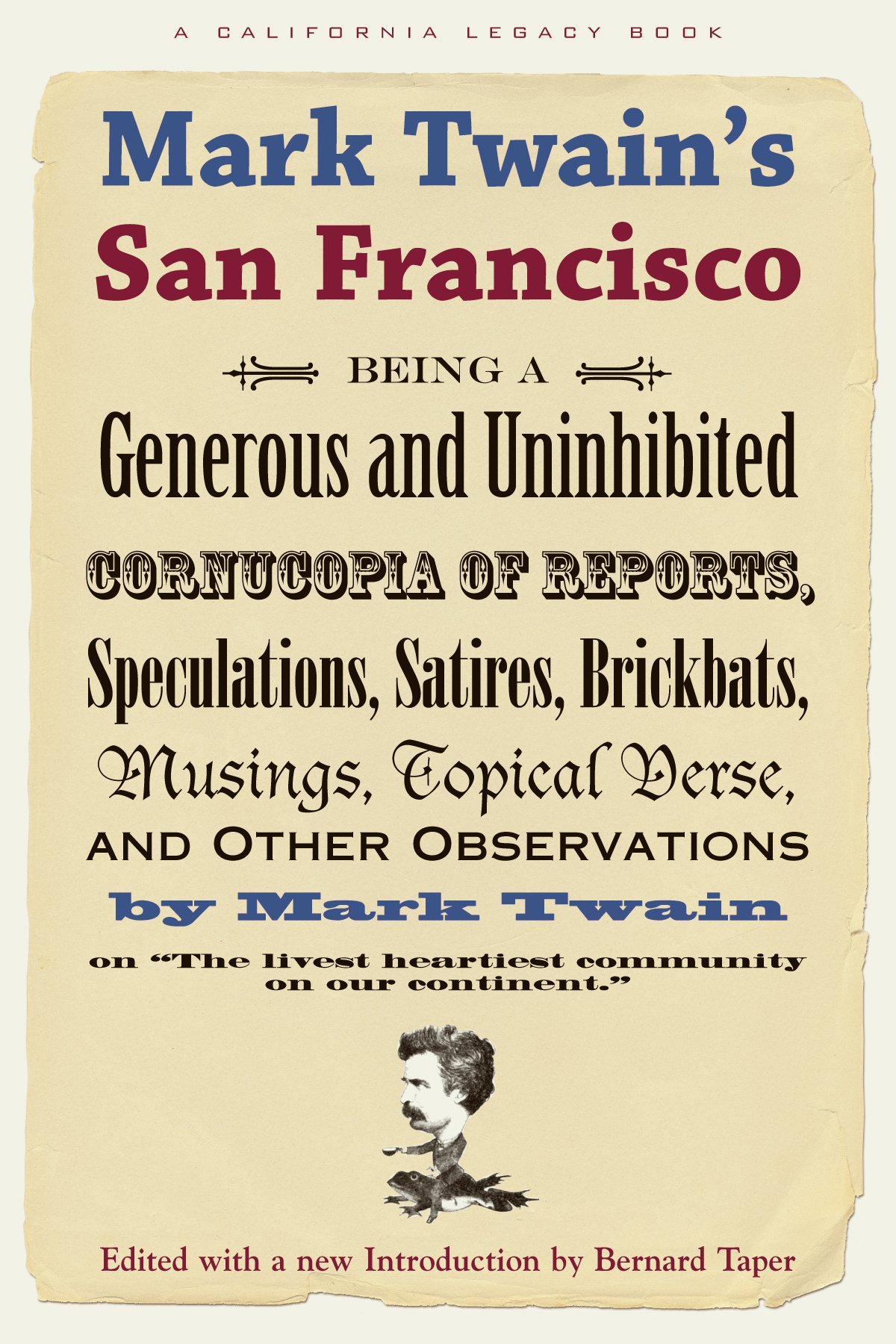 Book Summary: Jumping frogs, high society, beloved San Francisco characters Emperor Norton and the stray dogs Bummer and Lazarus who followed on his heels―nothing escaped Mark Twain’s scrutiny or his acerbic wit. Editor Bernard Taper has gathered together a heady selection of newspaper articles, correspondence, poetry, and short stories that are humorous―sometimes exasperating and controversial―but always engaging. Like a good sidekick in a comedy duo, Edward Jump, a contemporary of Twain’s, offers through his lively illustrations a visual drum roll to Twain’s cantankerous prose. From earthquakes, police scandals, and tantalizing silver mine bonanzas to elegant ladies blowing their noses in “exquisitely modulated tones” and seals “writhing and squirming like exaggerated maggots” below the Cliff House, Mark Twain has left us a vision of San Francisco that is at once fascinating and hilariously familiar.
Book Summary: Jumping frogs, high society, beloved San Francisco characters Emperor Norton and the stray dogs Bummer and Lazarus who followed on his heels―nothing escaped Mark Twain’s scrutiny or his acerbic wit. Editor Bernard Taper has gathered together a heady selection of newspaper articles, correspondence, poetry, and short stories that are humorous―sometimes exasperating and controversial―but always engaging. Like a good sidekick in a comedy duo, Edward Jump, a contemporary of Twain’s, offers through his lively illustrations a visual drum roll to Twain’s cantankerous prose. From earthquakes, police scandals, and tantalizing silver mine bonanzas to elegant ladies blowing their noses in “exquisitely modulated tones” and seals “writhing and squirming like exaggerated maggots” below the Cliff House, Mark Twain has left us a vision of San Francisco that is at once fascinating and hilariously familiar.
- Book Reviews:
69) Letters From Hawaii – 1966
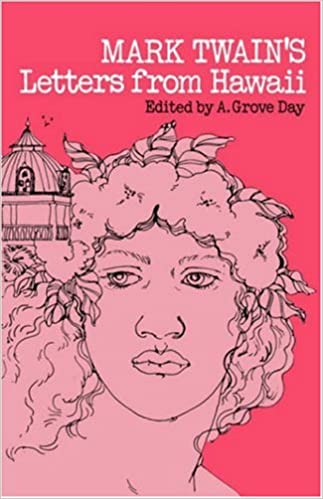 Book Summary: “I went to Maui to stay a week and remained five. I had a jolly time. I would not have fooled away any of it writing letters under any consideration whatever.” –Mark TwainSo Samuel Langhorne Clemens made his excuse for late copy to the Sacramento Union, the newspaper that was underwriting his 1866 trip. If the young reporter’s excuse makes perfect sense to you, join the thousands of Island lovers who have delighted in Twain’s efforts when he finally did put pen to paper.
Book Summary: “I went to Maui to stay a week and remained five. I had a jolly time. I would not have fooled away any of it writing letters under any consideration whatever.” –Mark TwainSo Samuel Langhorne Clemens made his excuse for late copy to the Sacramento Union, the newspaper that was underwriting his 1866 trip. If the young reporter’s excuse makes perfect sense to you, join the thousands of Island lovers who have delighted in Twain’s efforts when he finally did put pen to paper.
- Book Reviews:
70) Works of Mark Twain – 1972
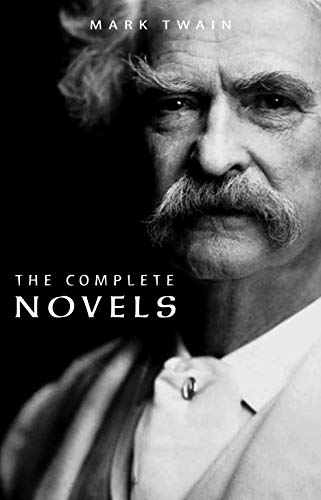 Book Summary: Here you will find the complete novels of Mark Twain in the chronological order of their original publication:- The Gilded Age: A Tale of Today
Book Summary: Here you will find the complete novels of Mark Twain in the chronological order of their original publication:- The Gilded Age: A Tale of Today
– The Adventures of Tom Sawyer
– The Prince and the Pauper
– The Adventures of Huckleberry Finn
– A Connecticut Yankee in King Arthur’s Court
– The American Claimant
– Tom Sawyer Abroad
– The Tragedy of Pudd’nhead Wilson
– Tom Sawyer, Detective
– Personal Recollections of Joan of Arc
– A Double Barrelled Detective Story
– A Horse’s Tale
– The Mysterious Stranger
- Book Reviews:
71) A pen warmed-up in hell – 1972
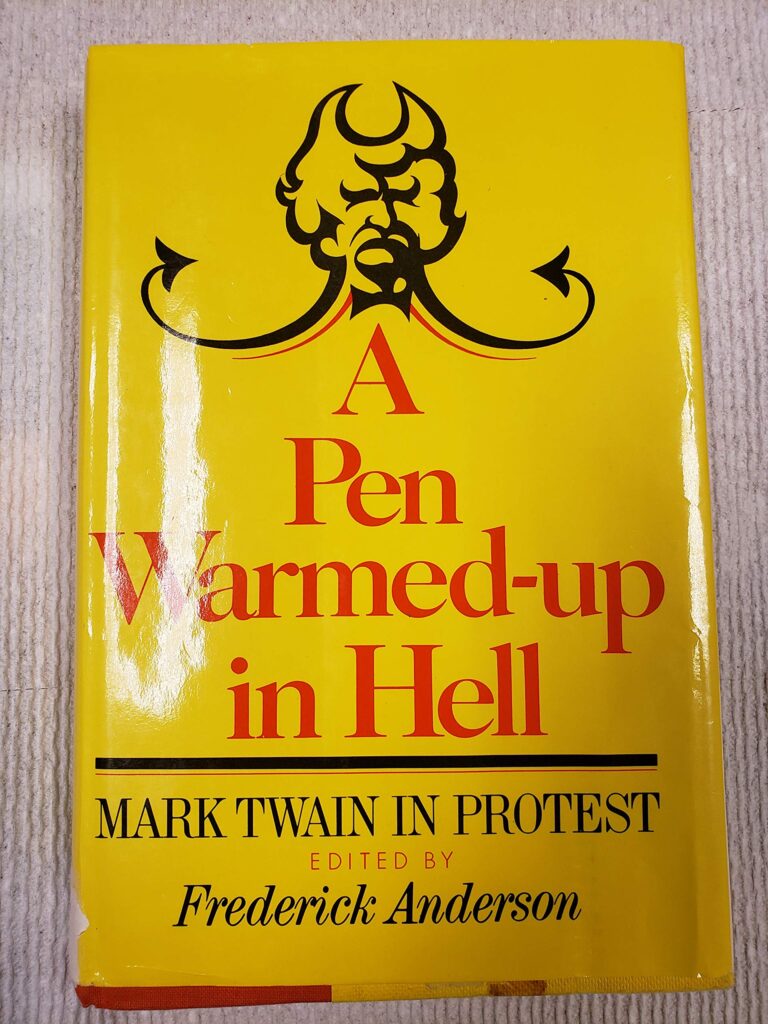 Book Summary: “Here is a book that is a pleasure to recommend. . . . A collection to be dipped into time and time again.”Los Angeles Times “Raging, satiric, devastatingly caustic and witty.”Publishers Weekly
Book Summary: “Here is a book that is a pleasure to recommend. . . . A collection to be dipped into time and time again.”Los Angeles Times “Raging, satiric, devastatingly caustic and witty.”Publishers Weekly
- Book Reviews:
72) The complete short stories of Mark Twain – 1979
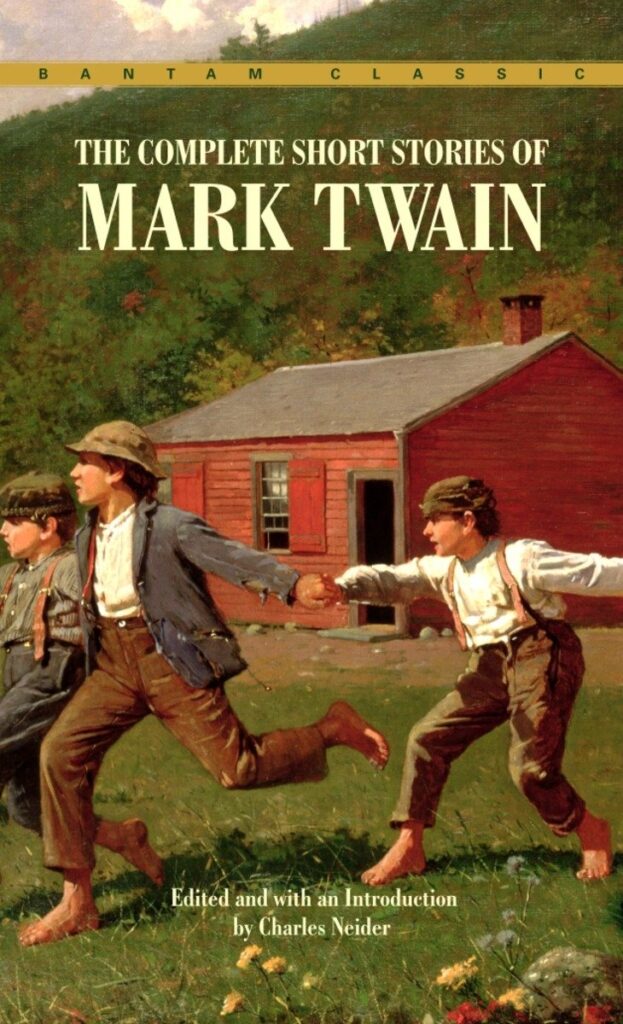 Book Summary: This carefully crafted ebook: “The Complete Short Stories of Mark Twain” is formatted for your eReader with a functional and detailed table of contents. The Complete Short Stories of Mark Twain is a collection of 169 short stories by the author. All the tales he wrote over the course of his lengthy career are gathered here, including such immortal classics as “The Notorious Jumping Frog of Calaveras County,” “The Man That Corrupted Hadleyburg,” “The Diary of Adam and Eve,” and “The $30,000 Bequest.” Twain’s inimitable wit, his nimble plotting, and his unerring insight into human nature are on full display in these wonderfully entertaining stories. Samuel Langhorne Clemens (1835 – 1910), better known by his pen name Mark Twain, was an American author and humorist. He wrote The Adventures of Tom Sawyer (1876) and its sequel, Adventures of Huckleberry Finn (1885), the latter often called “the Great American Novel.”
Book Summary: This carefully crafted ebook: “The Complete Short Stories of Mark Twain” is formatted for your eReader with a functional and detailed table of contents. The Complete Short Stories of Mark Twain is a collection of 169 short stories by the author. All the tales he wrote over the course of his lengthy career are gathered here, including such immortal classics as “The Notorious Jumping Frog of Calaveras County,” “The Man That Corrupted Hadleyburg,” “The Diary of Adam and Eve,” and “The $30,000 Bequest.” Twain’s inimitable wit, his nimble plotting, and his unerring insight into human nature are on full display in these wonderfully entertaining stories. Samuel Langhorne Clemens (1835 – 1910), better known by his pen name Mark Twain, was an American author and humorist. He wrote The Adventures of Tom Sawyer (1876) and its sequel, Adventures of Huckleberry Finn (1885), the latter often called “the Great American Novel.”
- Book Reviews:
73) The Adventures of Tom Sawyer and Huckleberry Finn – 1980
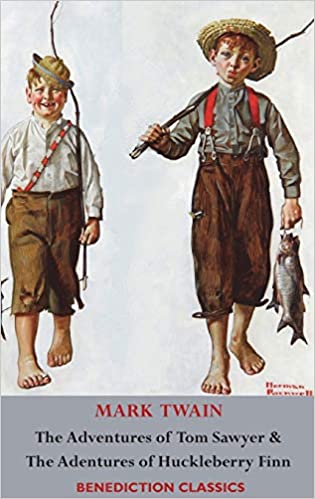 Book Summary: Tom Sawyer is an intelligent resourceful orphan who enjoys a life of freedom that is unsheltered from life’s hardships. He is an immediately attractive character who draws the reader through his adventures. Huck Finn is more superstitious and naïve, but still an adventurous survivor. Together they engage with their world in this classic coming of age story.What makes these two books classics? Twain’s characters are surprising, unforgettable and truly human. The dialog faithfully reproduces the common speech of his day. Twain explains, “In this book a number of dialects are used, to wit: the Missouri negro dialect; the extremest form of the backwoods Southwestern dialect; the ordinary ‘Pike County’ dialect; and four modified varieties of this last. The shadings have not been done in a haphazard fashion, or by guesswork; but painstakingly, and with the trustworthy guidance and support of personal familiarity with these several forms of speech.” The plot combines adventure, suspense and mischief with the darker side of humanity: murder, deceit, brutality and racial prejudice. Twain’s trademark humor and observations of human nature are never far.
Book Summary: Tom Sawyer is an intelligent resourceful orphan who enjoys a life of freedom that is unsheltered from life’s hardships. He is an immediately attractive character who draws the reader through his adventures. Huck Finn is more superstitious and naïve, but still an adventurous survivor. Together they engage with their world in this classic coming of age story.What makes these two books classics? Twain’s characters are surprising, unforgettable and truly human. The dialog faithfully reproduces the common speech of his day. Twain explains, “In this book a number of dialects are used, to wit: the Missouri negro dialect; the extremest form of the backwoods Southwestern dialect; the ordinary ‘Pike County’ dialect; and four modified varieties of this last. The shadings have not been done in a haphazard fashion, or by guesswork; but painstakingly, and with the trustworthy guidance and support of personal familiarity with these several forms of speech.” The plot combines adventure, suspense and mischief with the darker side of humanity: murder, deceit, brutality and racial prejudice. Twain’s trademark humor and observations of human nature are never far.
Hemingway concludes “All modern American literature comes from one book by Mark Twain called Huckleberry Finn . . . It is the best book we have.”
Features of this edition:
- Complete and unabridged
- Includes 335 original illustrations
- Crisp text set in modern easily read font.
- Book Reviews:
74) The Wit and Wisdom of Mark Twain – 1987
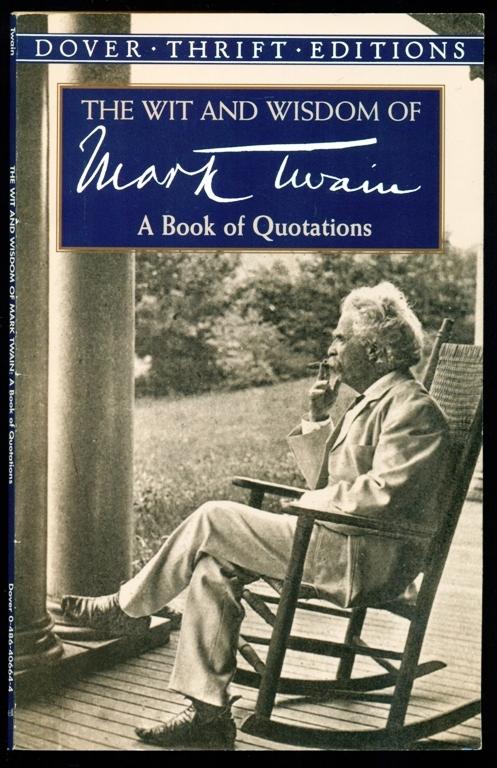 Book Summary: Renowned as a novelist, journalist, and humorist, Mark Twain is not only one of the most widely read and admired American writers, he is also among the most quoted. Wit and repartee permeate his work — from the short, light pieces to his great novel Adventures of Huckleberry Finn and even later, in dark meditations on the human condition where his humor takes on a cynical, satirical twist.
Book Summary: Renowned as a novelist, journalist, and humorist, Mark Twain is not only one of the most widely read and admired American writers, he is also among the most quoted. Wit and repartee permeate his work — from the short, light pieces to his great novel Adventures of Huckleberry Finn and even later, in dark meditations on the human condition where his humor takes on a cynical, satirical twist.
This remarkably inexpensive volume gathers together hundreds of Twain’s most memorable quips and comments on life, love, history, culture, travel, and a diversity of other topics that occupied his thoughts over 50 years of writing and lecturing.
An invaluable, ready reference for writers, speakers, and others in search of amusing and insightful quotes, this entertaining and thought-provoking compilation is also an ideal introduction to Twain’s inimitable style and thought.
- Book Reviews:
75) Mark Twain’s Helpful Hints for Good Living: A Handbook for the Damned Human Race – 1991
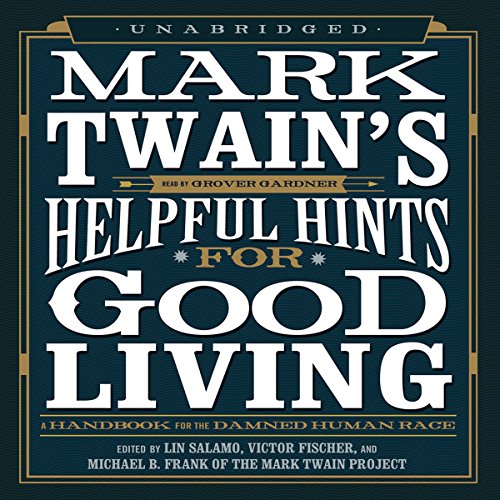 Book Summary: Irreverent, charming, and eminently quotable, this handbook – an eccentric etiquette guide for the human race – contains 69 aphorisms, anecdotes, whimsical suggestions, maxims, and cautionary tales from Mark Twain’s private and published writings. It dispenses advice and reflections on family life and public manners; opinions on topics such as dress, health, food, and childrearing and safety; and more specialized tips, such as those for dealing with annoying salesmen and burglars.Culled from Twain’s personal letters, autobiographical writings, speeches, novels, and sketches, these pieces are delightfully fresh, witty, startlingly relevant, and bursting with Twain’s characteristic ebullience for life. They also remind us exactly how Mark Twain came to be the most distinctive and well-known American literary voice in the world. These texts, some of them new or out of print for decades, have been selected and meticulously prepared by the editors at the Mark Twain Project.
Book Summary: Irreverent, charming, and eminently quotable, this handbook – an eccentric etiquette guide for the human race – contains 69 aphorisms, anecdotes, whimsical suggestions, maxims, and cautionary tales from Mark Twain’s private and published writings. It dispenses advice and reflections on family life and public manners; opinions on topics such as dress, health, food, and childrearing and safety; and more specialized tips, such as those for dealing with annoying salesmen and burglars.Culled from Twain’s personal letters, autobiographical writings, speeches, novels, and sketches, these pieces are delightfully fresh, witty, startlingly relevant, and bursting with Twain’s characteristic ebullience for life. They also remind us exactly how Mark Twain came to be the most distinctive and well-known American literary voice in the world. These texts, some of them new or out of print for decades, have been selected and meticulously prepared by the editors at the Mark Twain Project.
- Book Reviews:
76) The best short stories of Mark Twain – 2001
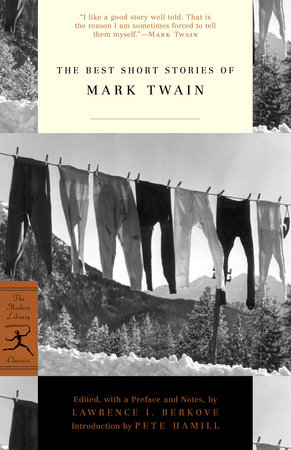 Book Summary: Mark Twain’s writing has been wildly popular ever since he put pen to paper, and now its popularity has continued into the new century.Mark Twain was well known as a great American short-story writer as well as a novelist and humorist. This collection of eighteen of his best short stories, the well known and the lesser known, displays his best-known side, as a master of Western humor and frontier realism, with little of the pessimism that surfaced in his later works.
Book Summary: Mark Twain’s writing has been wildly popular ever since he put pen to paper, and now its popularity has continued into the new century.Mark Twain was well known as a great American short-story writer as well as a novelist and humorist. This collection of eighteen of his best short stories, the well known and the lesser known, displays his best-known side, as a master of Western humor and frontier realism, with little of the pessimism that surfaced in his later works.
Beginning the collection is “Jim Smiley and His Jumping Frog,” which was Twain’s first successful story, published in 1865 in the New York Saturday Press. This comic version of an old folk tale became the title story of The Celebrated Jumping Frog of Calaveras County and Other Sketches, published in 1867, which was what established him as a leading American humorist.
Twain’s most distinctive work sums up the tradition of Western humor and frontier realism. Beginning as a journalist, he assumed the method and point of view of popular literature in the U.S., maintaining the personal anecdotal style that he also used in his comic lectures.
These stories display Twain’s place in American letters as a master writer in the authentic native idiom. He was exuberant and irreverent, but underlying the humor was a vigorous desire for social justice and a pervasive equalitarian attitude.
- Book Reviews:
77) Huck Finn and Tom Sawyer Among the Indians and Other Unfinished Stories – 1999
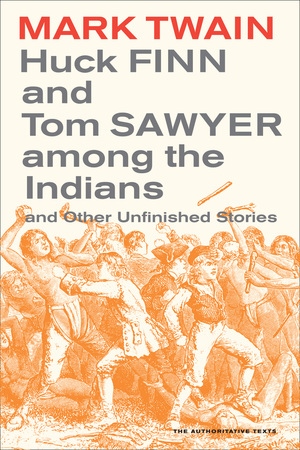 Book Summary: o Includes the authoritative texts for eleven pieces written between 1868 and 1902
Book Summary: o Includes the authoritative texts for eleven pieces written between 1868 and 1902
o Publishes, for the first time, the complete text of “Villagers of 1840-3,” Mark Twain’s astounding feat of memory
o Features a biographical directory and notes that reflect extensive new research on Mark Twain’s early life in Missouri
Throughout his career, Mark Twain frequently turned for inspiration to memories of his youth in the Mississippi River town of Hannibal, Missouri. What has come to be known as the Matter of Hannibal inspired two of his most famous books, Tom Sawyer and Huckleberry Finn, and provided the basis for the eleven pieces reprinted here. Most of these selections (eight of them fiction and three of them autobiographical) were never completed, and all were left unpublished. Written between 1868 and 1902, they include a diverse assortment of adventures, satires, and reminiscences in which the characters of his own childhood and of his best-loved fiction, particularly Huck Finn and Tom Sawyer, come alive again. The autobiographical recollections culminate in an astounding feat of memory titled “Villagers of 1840-3” in which the author, writing for himself alone at the age of sixty-one, recalls with humor and pathos the characters of some one hundred and fifty people from his childhood. Accompanied by notes that reflect extensive new research on Mark Twain’s early life in Missouri, the selections in this volume offer a revealing view of Mark Twain’s varied and repeated attempts to give literary expression to the Matter of Hannibal.
- Book Reviews:
78) Who Is Mark Twain? – 2009
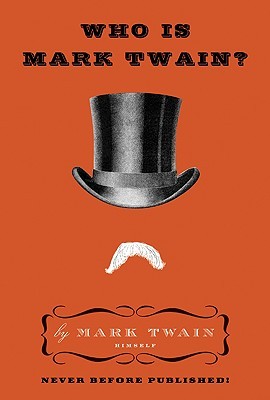 Book Summary: “[Twain] was, in the phrase of his friend William Dean Howells, ‘the Lincoln of our literature’… At the heart of his work lies that greatest of all American qualities: irreverence.”— Washington Post
Book Summary: “[Twain] was, in the phrase of his friend William Dean Howells, ‘the Lincoln of our literature’… At the heart of his work lies that greatest of all American qualities: irreverence.”— Washington Post
“More than 100 years after [Twain] wrote these stories, they remain not only remarkably funny but remarkably modern…. Ninety-nine years after his death, Twain still manages to get the last laugh.”
— Vanity FairWho Is Mark Twain? is a collection of twenty six wickedly funny, thought-provoking essays by Samuel Langhorne Clemens—aka Mark Twain—none of which have ever been published before, and all of which are completely contemporary, amazingly relevant, and gut-bustingly hilarious.
- Book Reviews:
79) Autobiography of Mark Twain – 2010
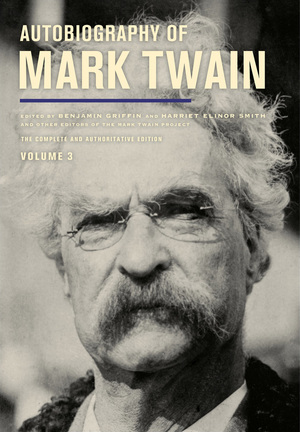 Book Summary: The surprising final chapter of a great American life.
Book Summary: The surprising final chapter of a great American life.
When the first volume of Mark Twain’s uncensored Autobiography was published in 2010, it was hailed as an essential addition to the shelf of his works and a crucial document for our understanding of the great humorist’s life and times. This third and final volume crowns and completes his life’s work. Like its companion volumes, it chronicles Twain’s inner and outer life through a series of daily dictations that go wherever his fancy leads.
Created from March 1907 to December 1909, these dictations present Mark Twain at the end of his life: receiving an honorary degree from Oxford University; railing against Theodore Roosevelt; founding numerous clubs; incredulous at an exhibition of the Holy Grail; credulous about the authorship of Shakespeare’s plays; relaxing in Bermuda; observing (and investing in) new technologies. The Autobiography’s “Closing Words” movingly commemorate his daughter Jean, who died on Christmas Eve 1909. Also included in this volume is the previously unpublished “Ashcroft-Lyon Manuscript,” Mark Twain’s caustic indictment of his “putrescent pair” of secretaries and the havoc that erupted in his house during their residency.
Fitfully published in fragments at intervals throughout the twentieth century, Autobiography of Mark Twain has now been critically reconstructed and made available as it was intended to be read. Fully annotated by the editors of the Mark Twain Project, the complete Autobiography emerges as a landmark publication in American literature.
Editors: Benjamin Griffin and Harriet Elinor Smith
Associate Editors: Victor Fischer, Michael B. Frank, Amanda Gagel, Sharon K. Goetz, Leslie Diane Myrick, Christopher M. Ohge
- Book Reviews:
80) The Purloining of Prince Oleomargarine – 2017
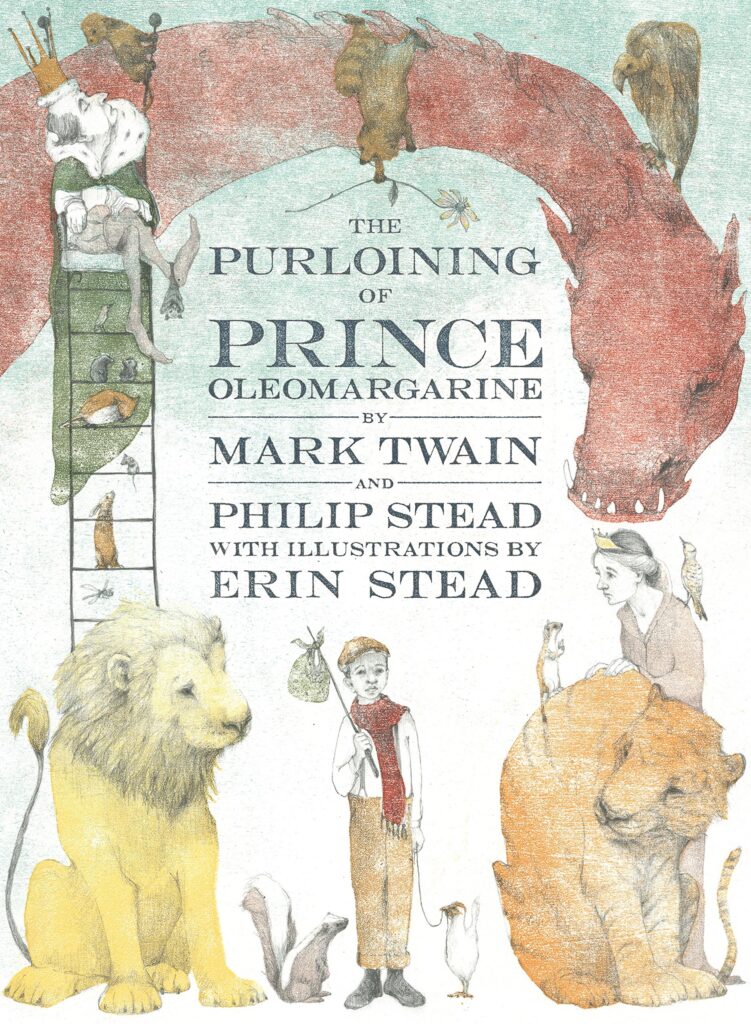 Book Summary: New York Times Bestseller!
Book Summary: New York Times Bestseller!
A School Library Journal Best Book of 2017A never-before-published, previously unfinished Mark Twain children’s story is brought to life by Philip and Erin Stead, creators of the Caldecott Medal-winning A Sick Day for Amos McGee.
In a hotel in Paris one evening in 1879, Mark Twain sat with his young daughters, who begged their father for a story. Twain began telling them the tale of Johnny, a poor boy in possession of some magical seeds. Later, Twain would jot down some rough notes about the story, but the tale was left unfinished . . . until now.
Plucked from the Mark Twain archive at the University of California at Berkeley, Twain’s notes now form the foundation of a fairy tale picked up over a century later. With only Twain’s fragmentary script and a story that stops partway as his guide, author Philip Stead has written a tale that imagines what might have been if Twain had fully realized this work.
Johnny, forlorn and alone except for his pet chicken, meets a kind woman who gives him seeds that change his fortune, allowing him to speak with animals and sending him on a quest to rescue a stolen prince. In the face of a bullying tyrant king, Johnny and his animal friends come to understand that generosity, empathy, and quiet courage are gifts more precious in this world than power and gold.
Illuminated by Erin Stead’s graceful, humorous, and achingly poignant artwork, this is a story that reaches through time and brings us a new book from America’s most legendary writer, envisioned by two of today’s most important names in children’s literature.
A Bank Street College of Education 2018 Best Children’s Book of the Year
“will capture the imaginations of readers of all ages”—USA Today, ★ ★ ★ ★ (out of four stars)
★ “Samuel Langhorne Clemens himself would be proud.”—Booklist, starred review
★ “a cast of eccentric characters, celestially fine writing, and a crusade against pomp that doesn’t sacrifice humor.”—Publishers Weekly, starred review★ “Completing a story penned by arguably America’s greatest author is no easy feat, but the Caldecott-winning author-illustrator (and husband-wife) team proves more than equal to the task. . . . A pensive and whimsical work that Twain would applaud.”—Kirkus, starred review
★ “The combination of Twain’s (often sarcastic) humor and “lessons of life,” a touch of allegory, and Stead’s own storytelling skills result in an awesome piece of fantasy.”—School Library Journal, starred review
★ “Beautifully understated and nuanced illustrations by Erin Stead add the finishing flourishes to this remarkable work.”—Shelf Awareness, starred review
“drawn with a graceful crosshatched intelligence that seems close to the best of Wyeth.”—Adam Gopnik, The New York Times
“Twain and the two Steads have created what could become a read-aloud classic, perfect for families to enjoy together.”—The Horn Book
“artful and meta and elegant”—The Wall Street Journal“should inspire readers young and old to seek further adventures with Twain.”—The Washington Post
- Book Reviews:
81) A Vintage Christmas: A Collection of Classic Stories and Poems – 2018
 Book Summary: This beautiful, giftable Christmas collection features old-fashioned works from classic authors who invite you to a feast of holiday nostalgia. Stories and poetry have been part of the Christmas season for generations, reminding us that the heart of the holiday never changes. A Vintage Christmas is a unique collection of lesser-known Christmas tales, reflections, and poems from beloved authors across the centuries and makes the perfect gift for the reader in your life.
Book Summary: This beautiful, giftable Christmas collection features old-fashioned works from classic authors who invite you to a feast of holiday nostalgia. Stories and poetry have been part of the Christmas season for generations, reminding us that the heart of the holiday never changes. A Vintage Christmas is a unique collection of lesser-known Christmas tales, reflections, and poems from beloved authors across the centuries and makes the perfect gift for the reader in your life.
Discover the charming story from L. M. Montgomery about love and sacrifice in a little log house. See Christmas through the eyes of a child in a New England colonial village with Harriet Beecher Stowe. Remember the reason Christ came to earth in the poetry of Anne Brontë. Share with your family the delightful letter Mark Twain wrote as Santa Claus to his three-year-old daughter.
This beautiful treasury takes us back to the firesides, simple gifts, and warm family moments of Christmases past as we cherish the timeless truths and joys of the season.
A Vintage Christmas includes stories from Louisa May Alcott, Charles Dickens, Ralph Henry Barbour, Harriet Beecher Stowe, Mark Twain, L. M. Montgomery, and William Dean Howells, as well as poems from Eliza Cook, Christina Rossetti, William Makepeace Thackeray, Joyce Kilmer, Henry Wadsworth Longfellow, and Samuel Taylor Coleridge.
- Perfect as a stocking stuffer or as a host or hostess gift
- Hardcover, giftable size for readers
- Makes a lovely keepsake companion to A Classic Christmas: A Collection of Timeless Stories and Poems
- Includes hopeful and encouraging Christmas stories
- Book Reviews:
Conclusion
If you are looking for another author, book series or even genre to read next then check out our collection of must reads here.



